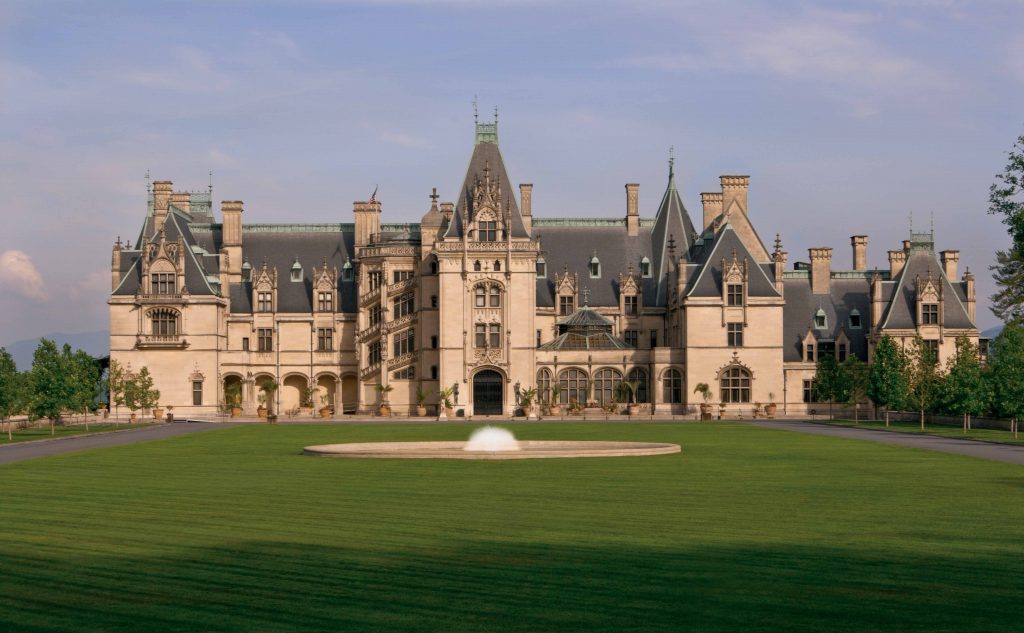Making the Most of Your Visit to the Biltmore Estate
On Christmas Eve 1895, George Washington Vanderbilt, a member of the wealthy Vanderbilt industrialist family, opened his newly built, two-hundred and fifty room home to guests for the first time. It took six years to build and the property covered 125,000 acres. Vanderbilt had discovered the town, Asheville, NC, while visiting his mother there in 1888. He admired the beauty of the town and selected it to be the location for his country chateau. While Vanderbilt had a vision and dream for the Biltmore, he would be amazed that the Biltmore would remain the largest privately owned estate in America and grow into a powerful brand that would bring tourists from all over the world to Asheville, NC over the next one hundred plus years.
My first visit to the Biltmore Estate was in the winter 1977. Then the tour was a personal guided tour of only the mansion. We have visited several times over the years and always enjoy our visit. Each Biltmore visit has something new or intriguing that we learn about the house, the estate, the family and more. Today the house tours are audio-guided tours. When going to the Biltmore plan a full day, as there are so many things to do and see. Arrive early, to assure time to explore the Conservatory, The Gardens, Antler Village, the Farmyard, the Winery, The Biltmore Legacy and more. This article outlines a day at The Biltmore focusing on the Conservatory, Gardens, and especially the Biltmore House tour. Join our photographic tour, along with some tips, of our one-day excursion to the fantastic Biltmore Estate. It will bring fond memories to those who have visited in the past, entice those who have not visited, and be an armchair tour for others.
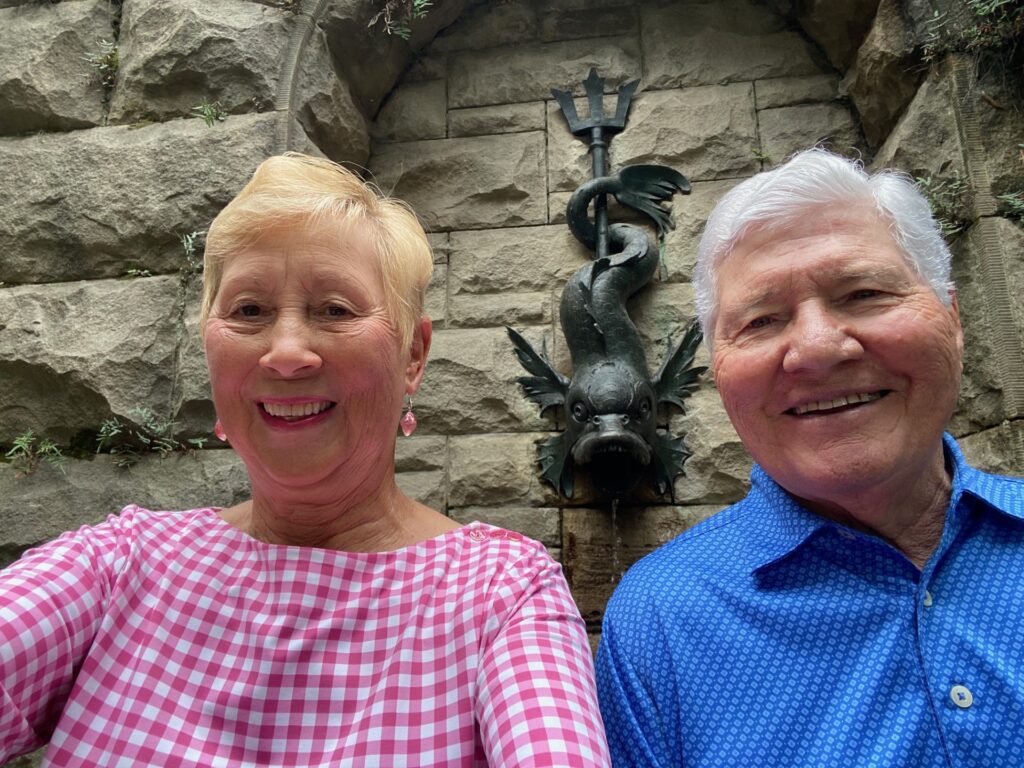
The Mixa’s Recommendations for Visiting the Biltmore Estate:
- Prepurchase your tickets either through AAA, online, or other websites. On this visit our rental with Carolina Mornings Vacation Rentals provided one complimentary pass each day to various attractions though Explor!e. We easily arranged for the complimentary day pass and purchased the 2nd one. Like a BOGO for us.
- Wear good walking shoes. The Biltmore requires a lot of walking to truly experience all that it offers. The House Tour itself covers 3 main floors and the basement. Be prepared to walk up and down a lot of stairs.
- Attempt to get an early tour of the house to have time to explore other areas later. Otherwise, arrive early around 9:00AM before the crowds come and enjoy activities before the Biltmore House tour.
- Stop at the Reception and Ticketing Sales Center on arrival at the Estate. Staff can answer any questions, watch a Welcoming movie about the Biltmore Estate, the family and more. This is a good bathroom stop before exploring the Estate.
- We recommend parking at the Garden Parking area. Follow the signs to the parking area which is just after Biltmore House and the Conservatory. Yes, the road actually goes through the Walled Gardens. There is a paved lot behind the Conservatory. If it is full, follow the sign to additional parking for the Conservatory. This currently is an unpaved lot.
- From the parking area it is a short walk to the Conservatory where you can begin to explore the estate.
- From the Conservatory stroll through the Walled Gardens, Rose Garden, and out the Shrub Garden. The Path leads up to the Italian Gardens and then to the South Terraces of the mansion.
- After touring the Gardens and House, return to your car via the Gardens (yes, you’ll stop to take a few more pictures.)
- Next drive the scenic five miles to Antler Village. There are several parking lots there. Getting food here is a good option, plus several activities to see and do. These include the Antler Barn, The Farmyard, the Winery, Village Green and The Biltmore Legacy. Children will especially enjoy the Barn, Farymyard and Pisgah Playground.
- Be ready to learn about the Gilded Age and challenges the Biltmore has faced over the years, as well as, the impact this estate has had on Asheville and the western North Carolina mountains.

THE GARDENS AT THE BILTMORE
Biltmore offers magnificent gardens on it 8,000 acres. There are six formal and informal gardens, a conservatory, and nature trails connecting them to the French Broad River, the estate’s Deer Park, Lagoon, Farmyard and woodlands. On this visit we stroll the gardens nearest the house.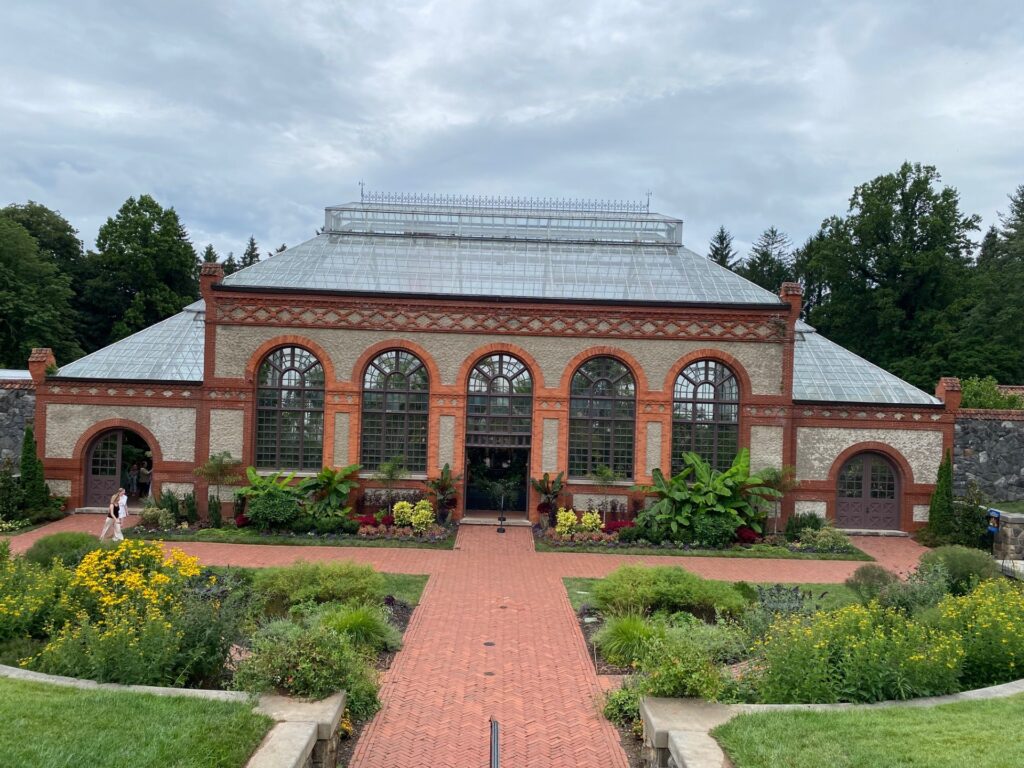 THE CONSERVATORY AT THE BILTMORE ESTATE
THE CONSERVATORY AT THE BILTMORE ESTATE
The beautiful Conservatory from the steps of the Walled Garden. Our visit starts in the Conservatory.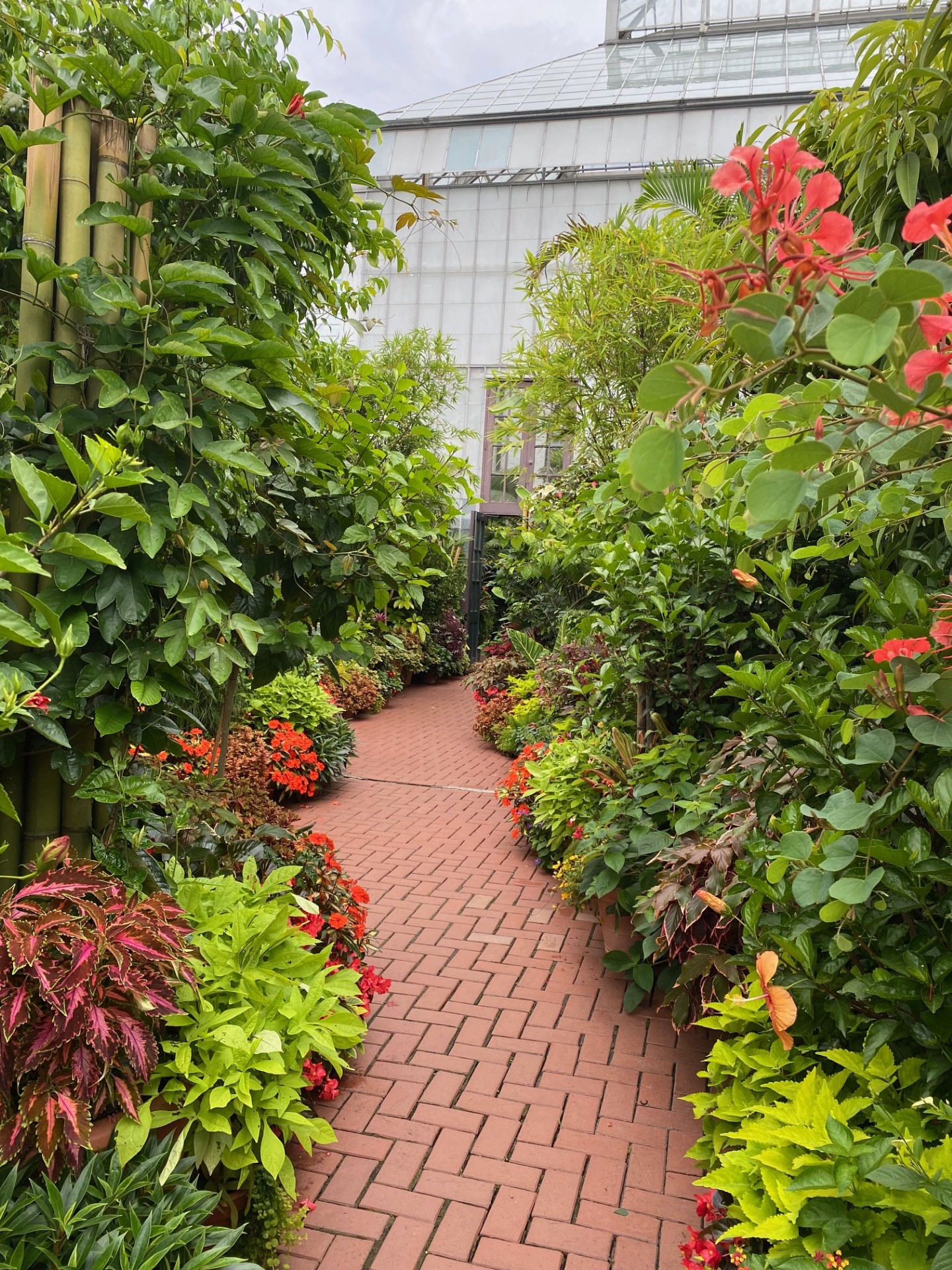 Entering the Conservatory, we opt to start upstairs as the Gardner’s Place Shop is on lower level. Inside we find a huge variety of plants, trees, etc. There are different sections designed for specific type of conditions for the plants.
Entering the Conservatory, we opt to start upstairs as the Gardner’s Place Shop is on lower level. Inside we find a huge variety of plants, trees, etc. There are different sections designed for specific type of conditions for the plants.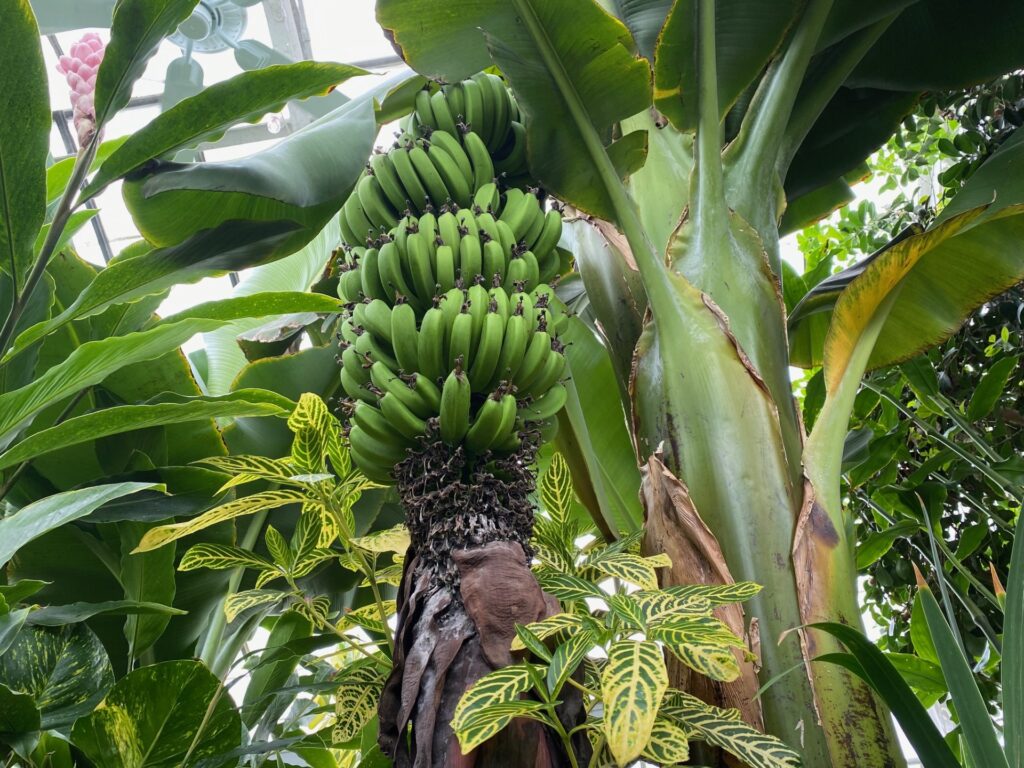 Even Bananas are found in the Conservatory
Even Bananas are found in the Conservatory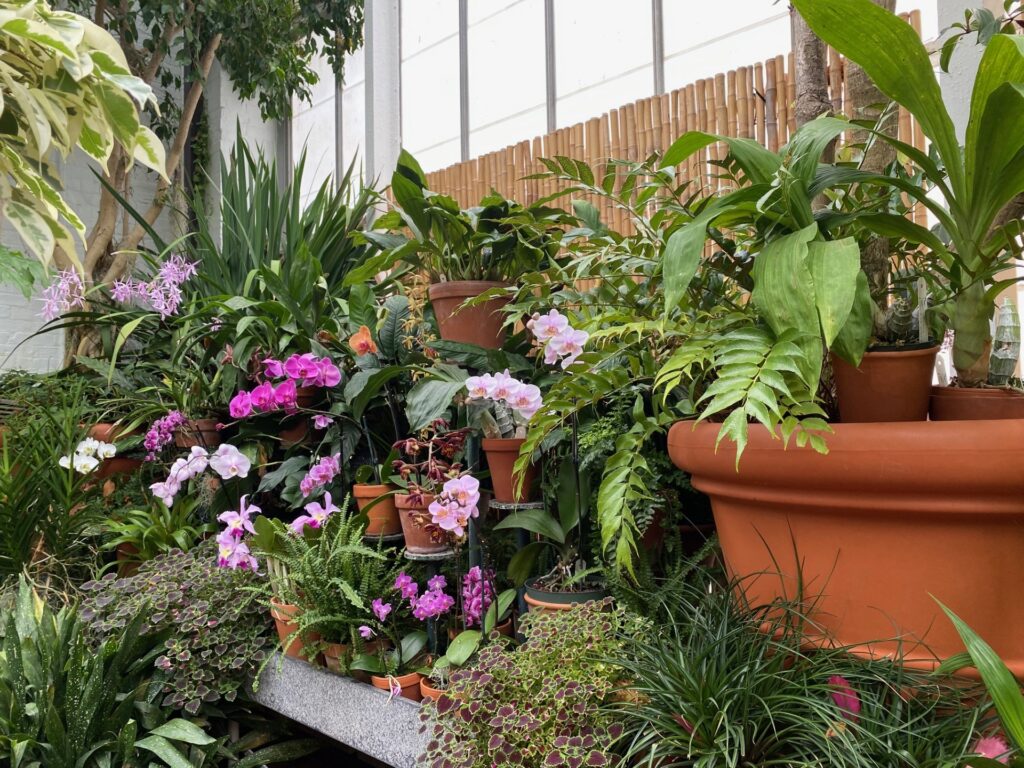 Take your time and stroll the Conservatory delighting in the beautiful Orchid Garden.
Take your time and stroll the Conservatory delighting in the beautiful Orchid Garden.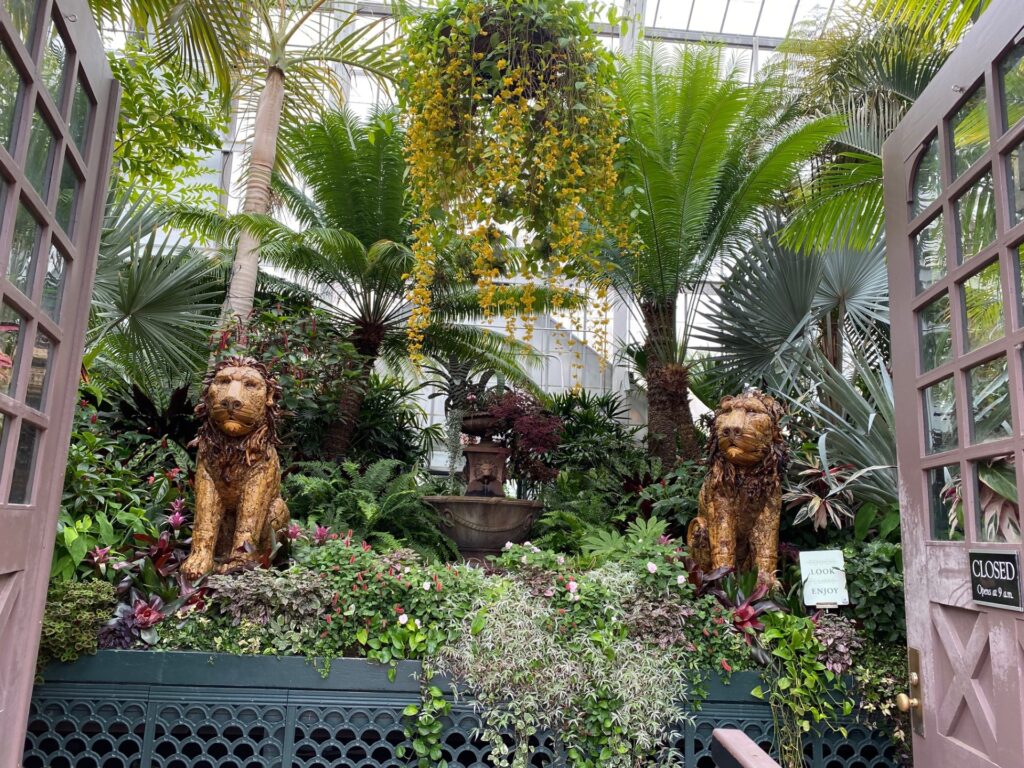 Walk around a corner to find another unique and special garden setting with Lions and a Fountain.
Walk around a corner to find another unique and special garden setting with Lions and a Fountain.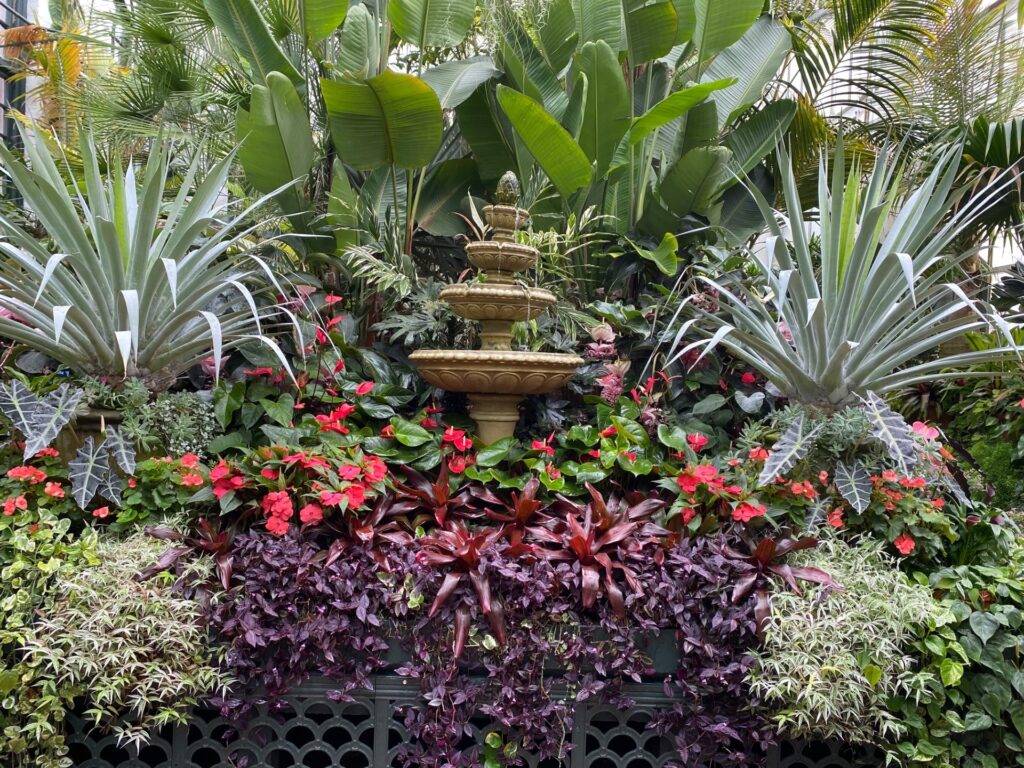 A small fountain creates a cozy atmosphere.
A small fountain creates a cozy atmosphere.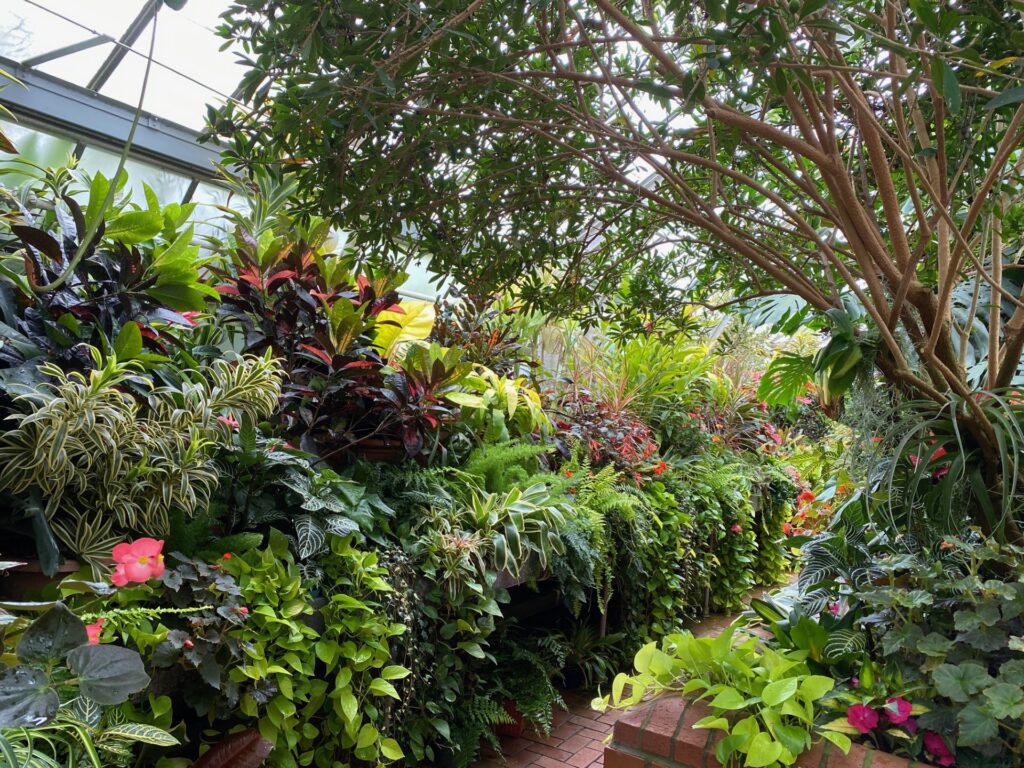 See lushness of the HOT House Plants and stroll the brick path for more exotic plants.
See lushness of the HOT House Plants and stroll the brick path for more exotic plants.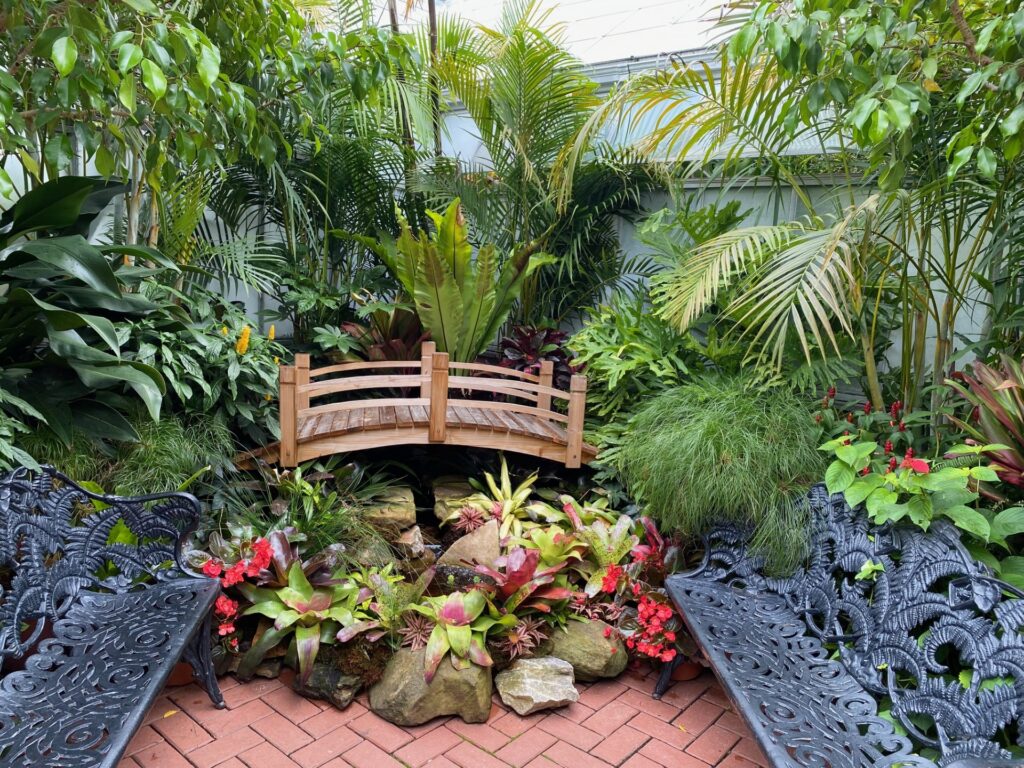 Take in all the beauty of the Conservatory on your visit. Even take time to sit on a bench and relax in this peaceful beautiful setting.
Take in all the beauty of the Conservatory on your visit. Even take time to sit on a bench and relax in this peaceful beautiful setting.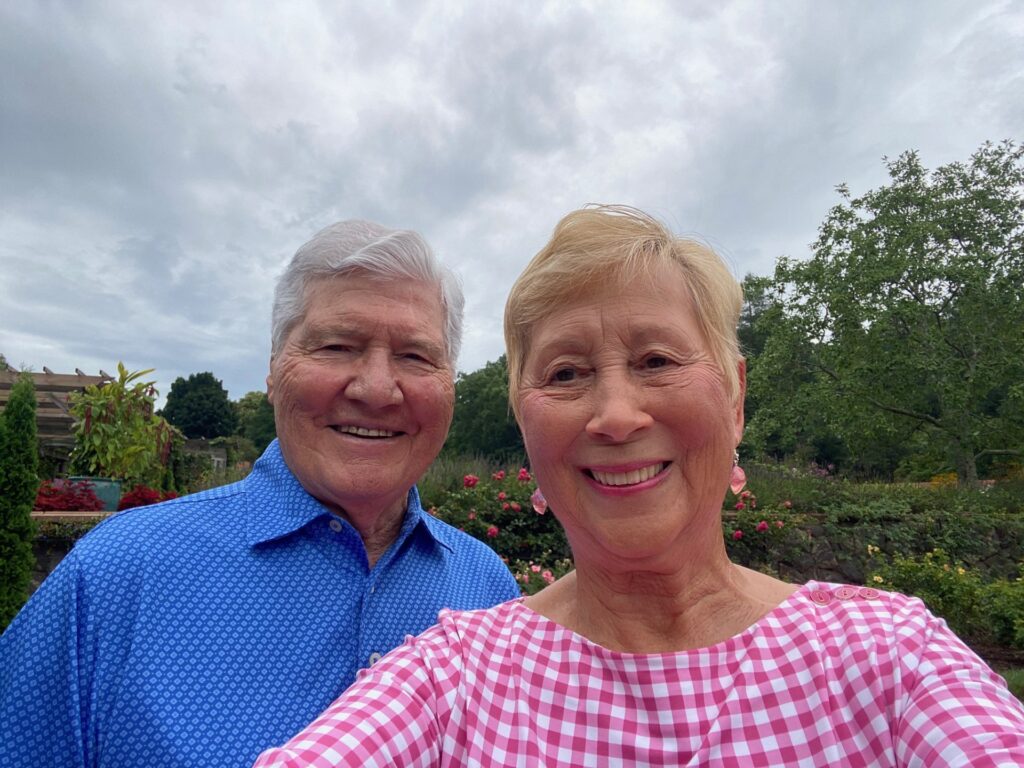 The Rose Garden and Walled Garden
The Rose Garden and Walled Garden
Exit the Conservatory to now enjoy the Rose Gardens, the Arbor and walkway down the center of the gardens, and the Walled Garden. Take time to admire the beauty and elegant designs of the flower beds along with the variety of flowers and plants. These change with the seasons. On this summer visit, the Roses are not as lush, but the gardens are each beautifully maintained and manicured. Again, we are letting the pictures show off the these magnificent gardens. This is our selfie with the Rose Garden in the background.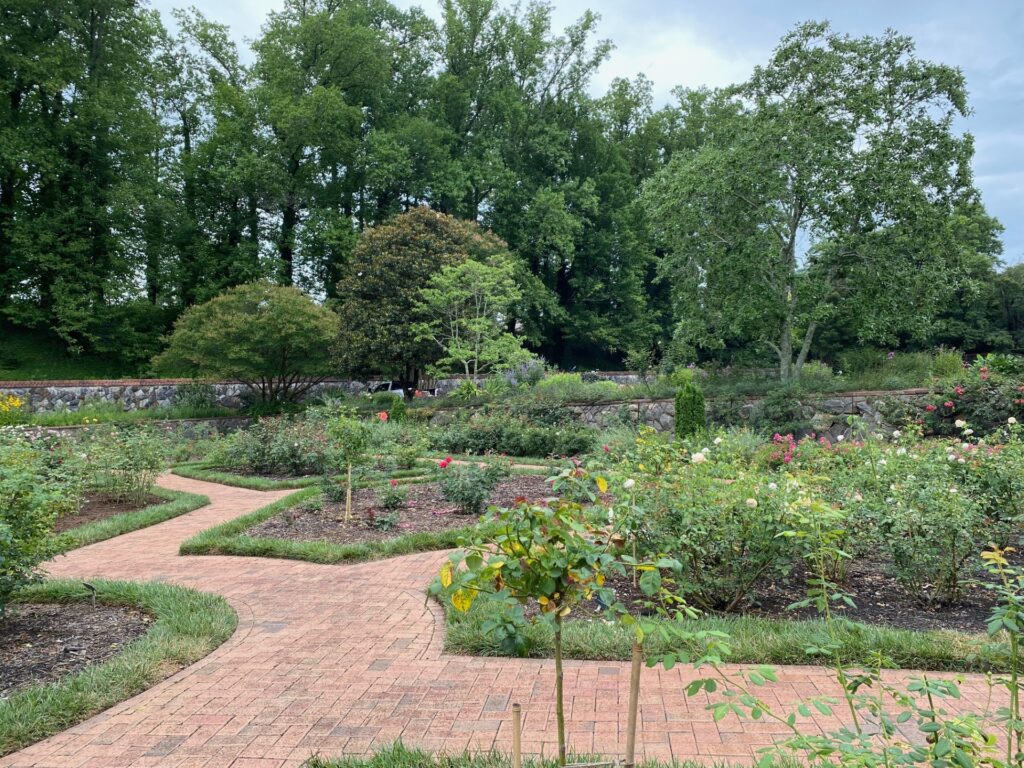 Walkways of the Walled Garden
Walkways of the Walled Garden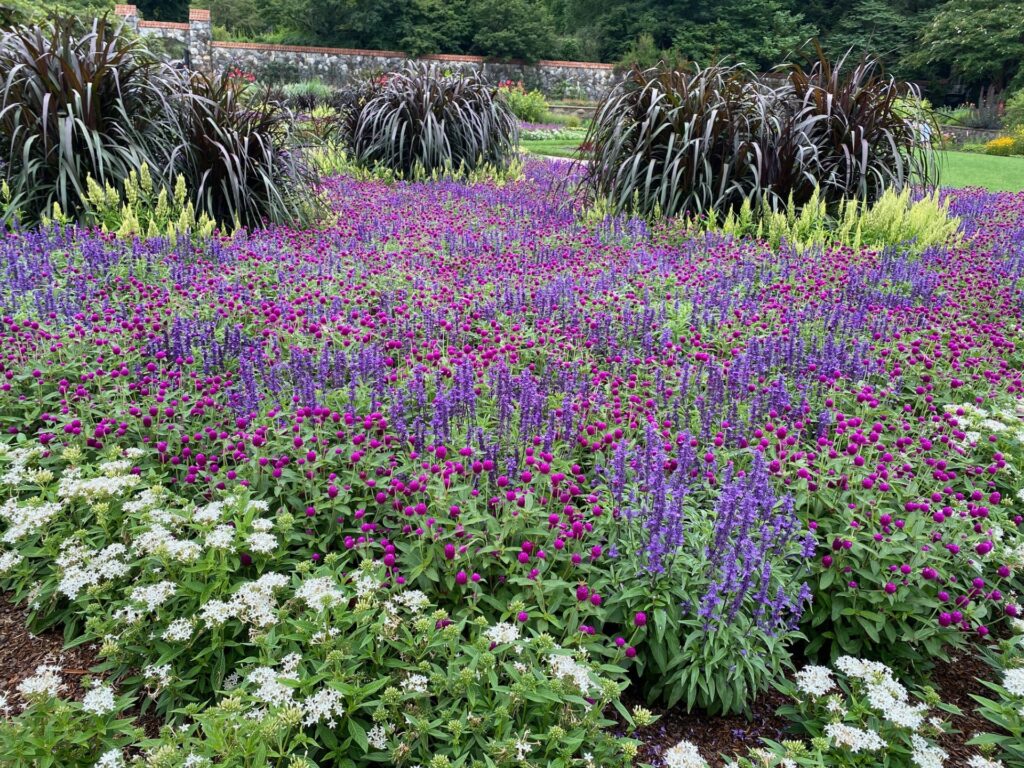 Flowers are blooming in the Walled Garden.
Flowers are blooming in the Walled Garden. 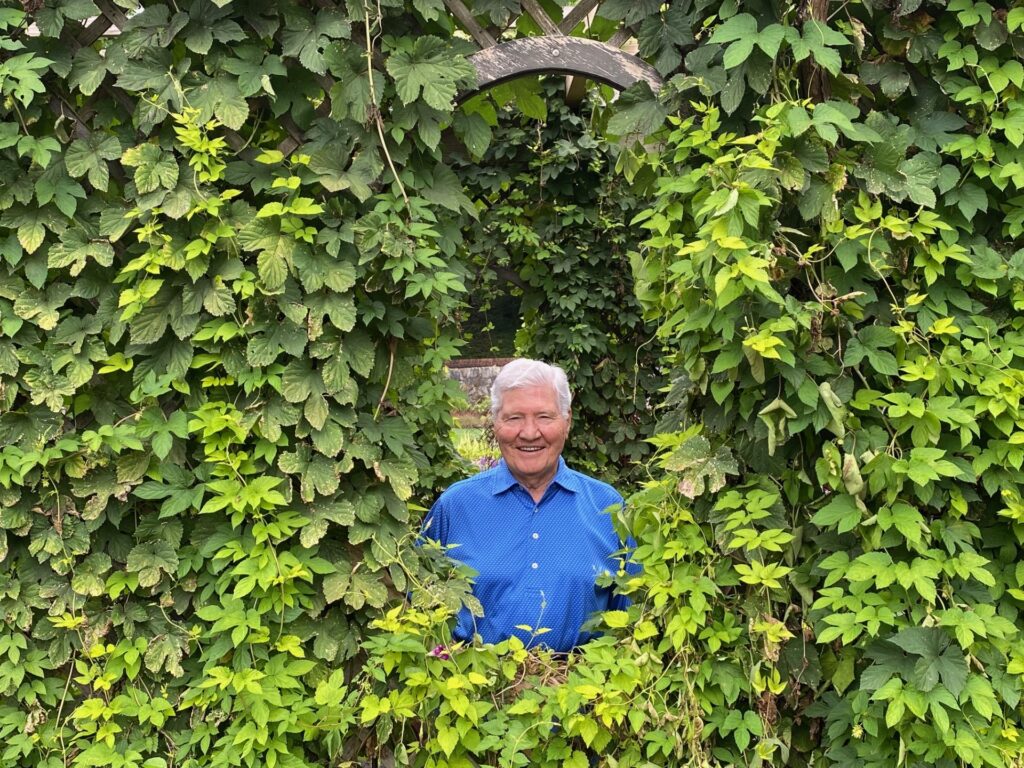 Take some fun photos at the arbor.
Take some fun photos at the arbor.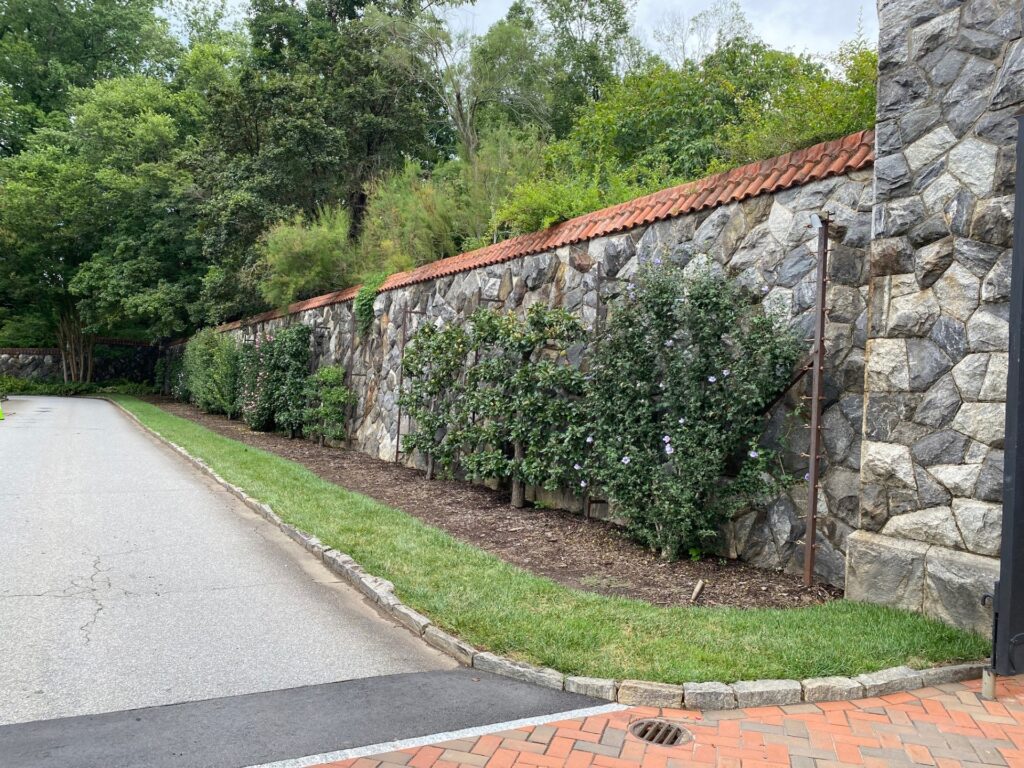 This shows the stone wall of the Walled Garden and the road to the Conservatory Parking area. From the Walled Garden, we stroll along the pathways in the shade of trees and foilage of the Shrub Gardens to the Italian Gardens. For garden enthusiast other garden options include:
This shows the stone wall of the Walled Garden and the road to the Conservatory Parking area. From the Walled Garden, we stroll along the pathways in the shade of trees and foilage of the Shrub Gardens to the Italian Gardens. For garden enthusiast other garden options include:
- Shrub Garden Path a 1/3/ mile loop
- Spring Garden Path a ¼ mile
- Azalea Garden Path 1/3 mile loop from Conservatory to Bass Pond (definitely a spring activity).
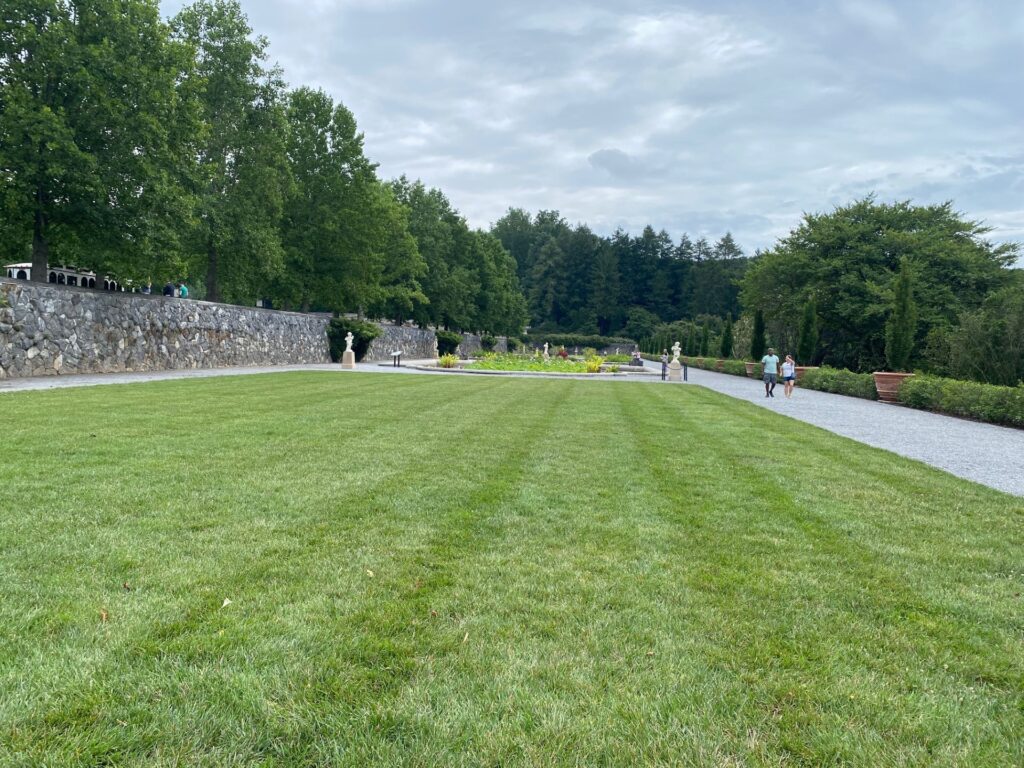
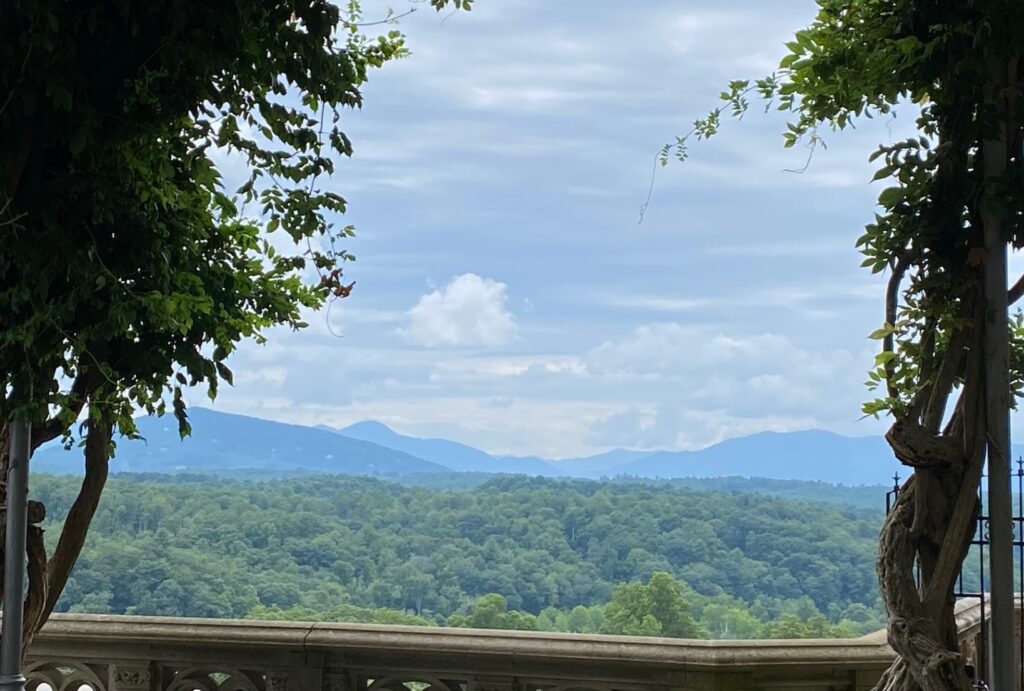
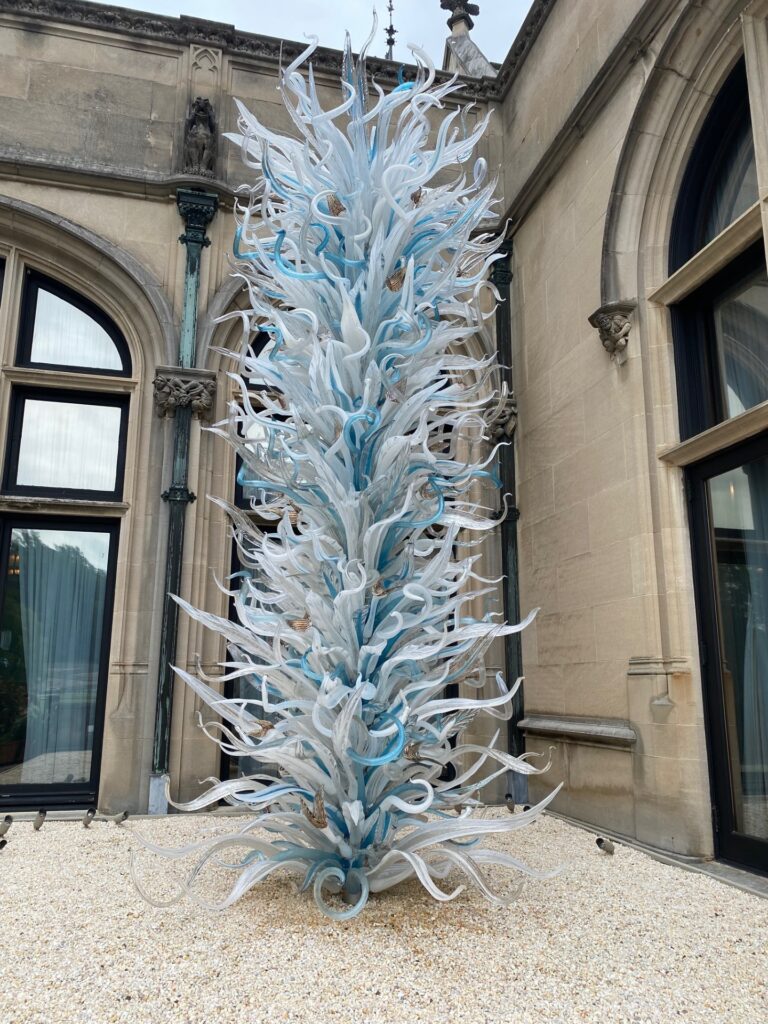
THE BILTMORE HOUSE
From South Terrace we walk past the Biltmore House heading over to the Stable Courtyard. Here are nice Rest Rooms and lockers. For those wanting to dine, Stable Café has a huge dining area. Check ahead for reservations and also hours of operation. Shoppers will enjoy the various shops at Stable Courtyard of A Christmas Past, Bookbinder’s, Carriage House, Confectionary, Toymaker’s and Biltmore Dairy Bar. If you make any purchases, we suggest doing it after the House Tour, getting a locker for your purchases, or taking it back to your car. You go through a security check to enter Biltmore House.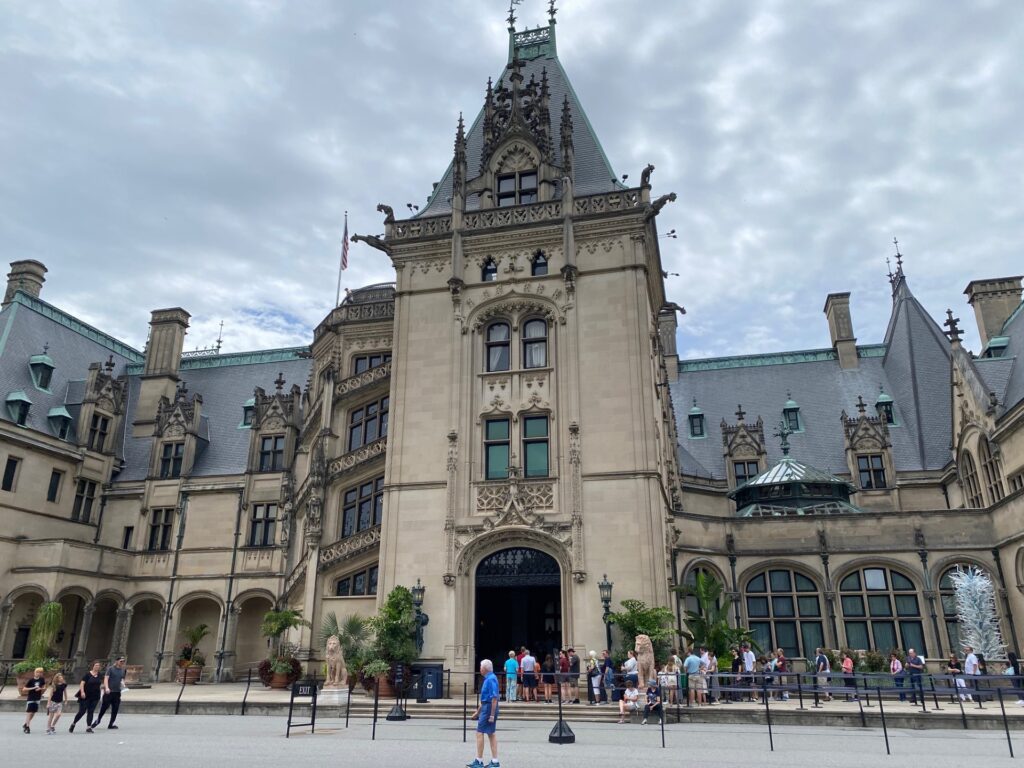
People line up for the tour of the Biltmore House.Time for our audio-guided tour of the Vanderbilt family’s magnificent home. We arrive 15 minutes prior to our 1:30PM tour time. Quickly we are in line and ready to begin the Biltmore House Tour. Receiving our audio-guided tour equipment we walk to each designated sign to listen to the details of that Stop. There are 36 Stops. At Stop 1 Welcome and Introduction, we learn some history and details of the Biltmore House. Biltmore’s architecture is based on French Medieval and Renaissance castles. The house is a staggering 175,000 square feet (four acres) with 33 bedrooms, 65 fireplaces and 43 bathrooms. Almost 10 million pounds of limestone was used to build it. Additionally, some stops have extra details explaining life in that era, stories of workers, explanation of the role of workers and more. While on the tour, we will see many of the Biltmore Collection throughtout Biltmore House. The Collection has more than 92,000 items—from architectural drawings of Biltmore House to works by Monet, Renoir, and more. Below are the rooms and information on the Tour Stops.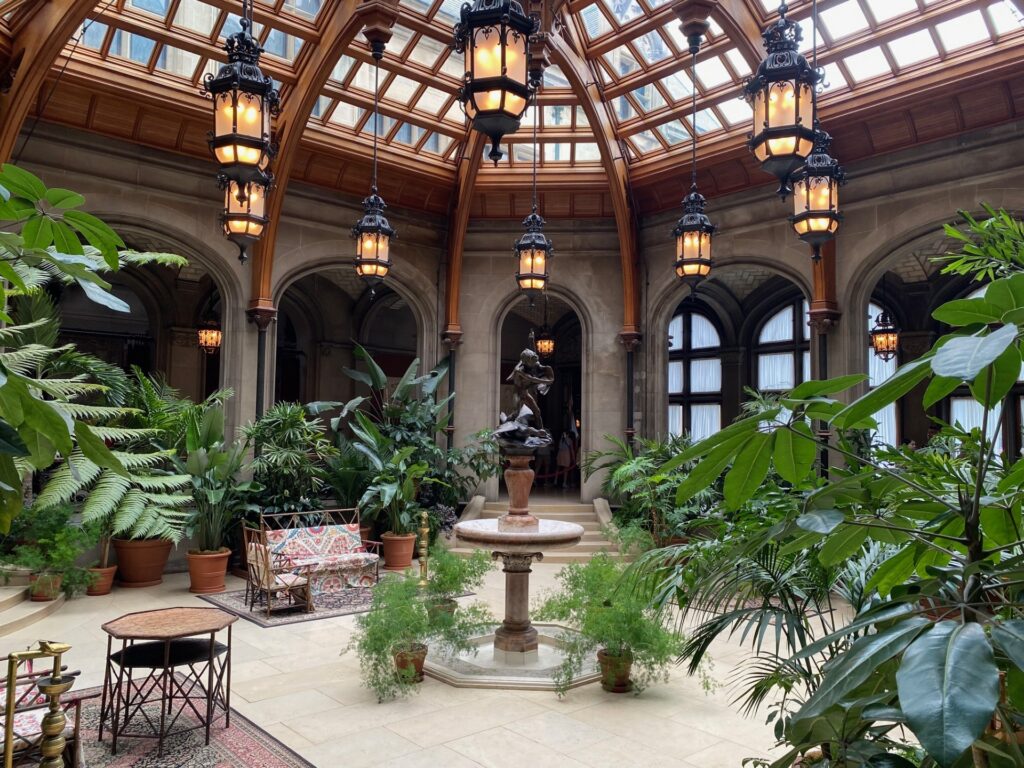
Winter GardenWinter Garden: The lushness of the Winter Garden is mesmerizing. On my first visit in 1977, it had snowed, so seeing the foliage in the Winter Garden added an extra warmth to this massive house. The statue in the center is the Boy with Goose. .
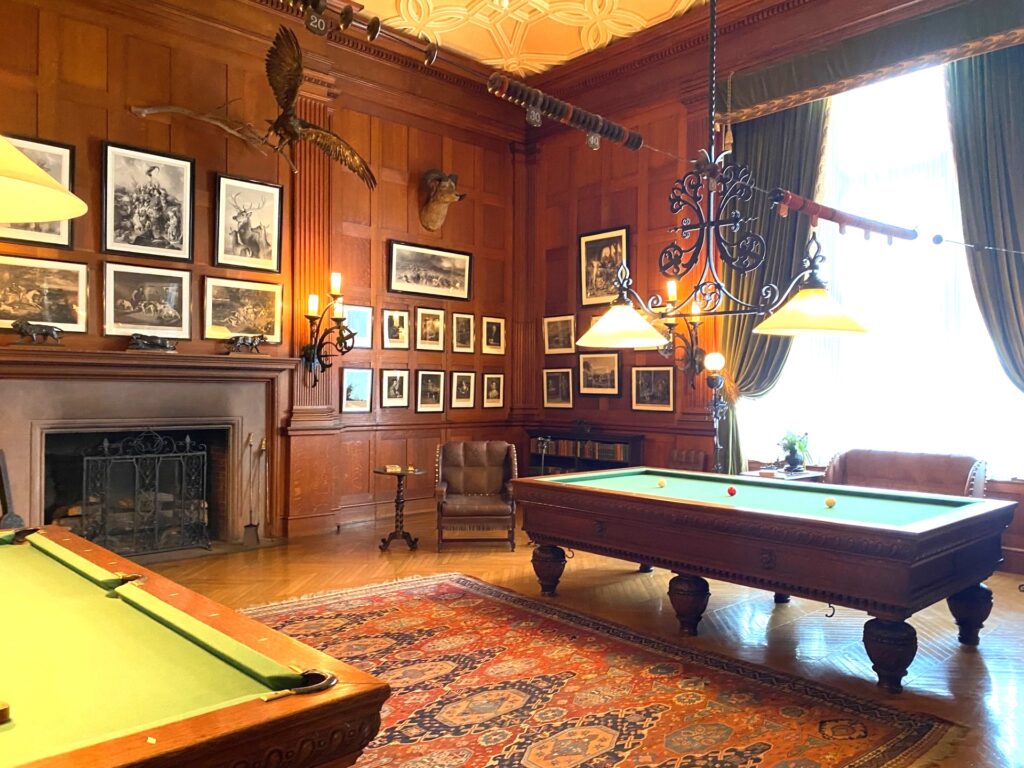
The Billiard Room: Here we see the beauty of the room, the elaborate ceiling, and a variety of pictures on the wall. As a young man, George Vanderbilt traveled the world amassing a vast collection of works of art, furnishings, tapestries, paintings, and more that were utilized in decorating Biltmore House.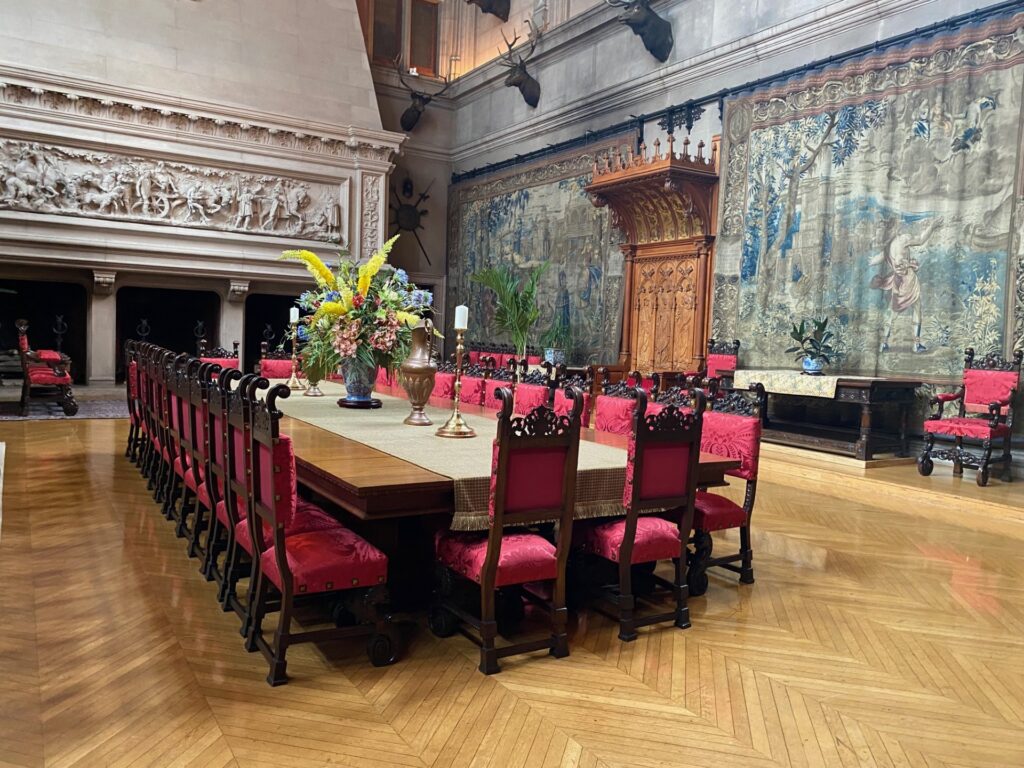 Banquet Hall
Banquet Hall
The Banquet Hall: Here the Vanderbilt’s entertained their guests dining in magnificent fashion. There would be multi-course meals. It could be an 11-course dinner.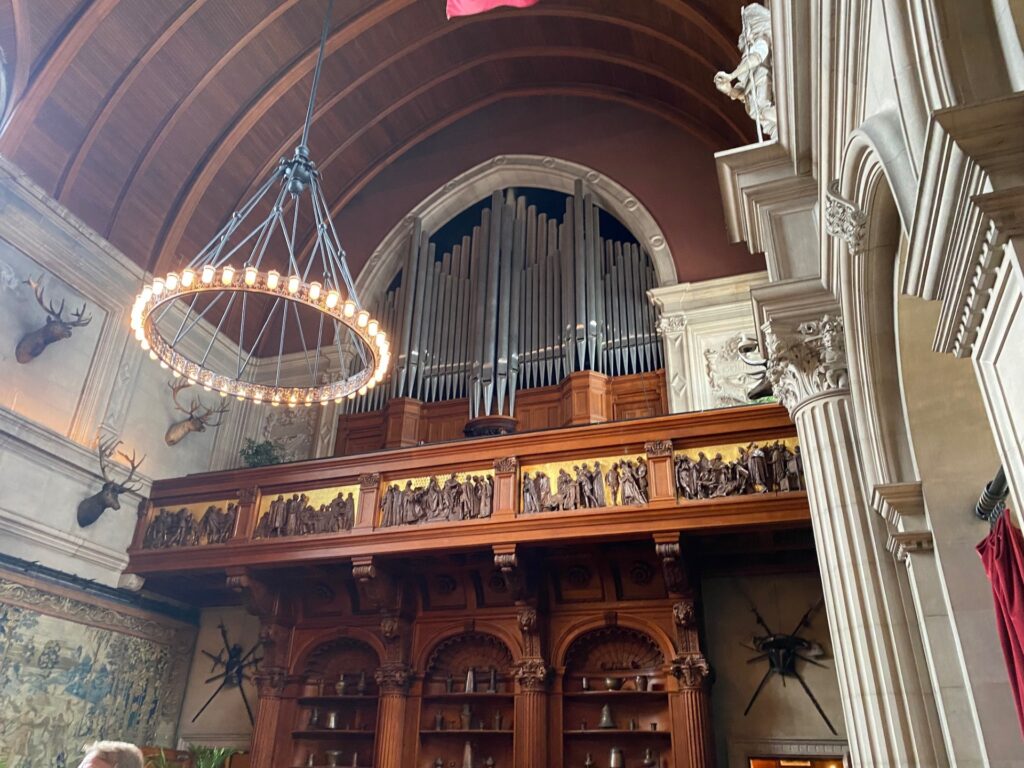 Pipe Organ in the Banquet Hall
Pipe Organ in the Banquet Hall
Organ in Banquet Hall: This massive pipe organ is so impressive. Listening carefully, we hear music of this wonderful organ. Later in the basement, we see the large fan that creates air for the pipe organ in the Banquet Hall. Breakfast Room
Breakfast Room
Breakfast Room: Imagine dressing for breakfast to dine in the elegant Breakfast Room. In this room we learn details of the paintings on each side of the fireplace, the tiles of the fireplace and other notable items in the room. To protect these antiques, wall paper, draperies, etc. the lighting is kept very low. During Vanderbilt’s life, the huge windows would be open providing sunlight and mountain views.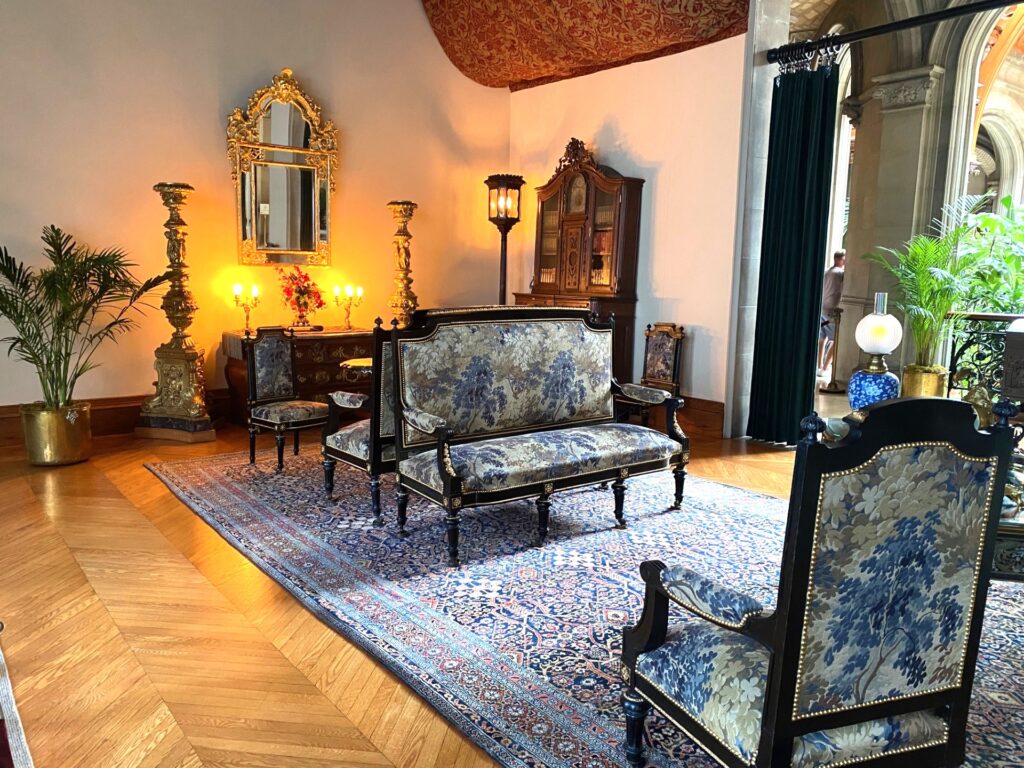 Salon by the Breakfast Room
Salon by the Breakfast Room
Salon by Breakfast Room: Here guests and family would gather and visit before and after breakfast. The blue decor of the room creates a cozy relaxing area for family and guests. George Vanderbilt acquired a plethora of antiquities, furnishings, paintings and more. These were well utilized in the decoration of the Biltmore House.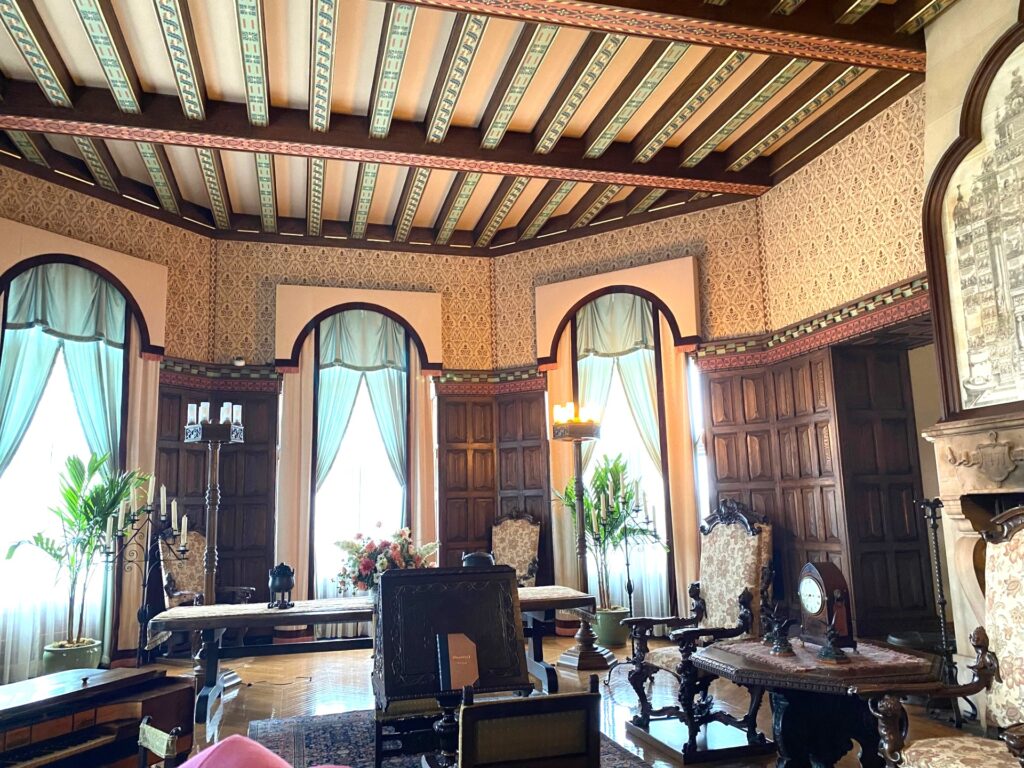 Music Room
Music Room
The Music Room: During Vanderbilt’s life, the Music Room was not finished. It has been decorated based on how it was expected to be done. The Biltmore was chosen to house the historical art pieces from the National Gallery of Art during WWII in case the US was attacked. This room housed those numerous pieces of art.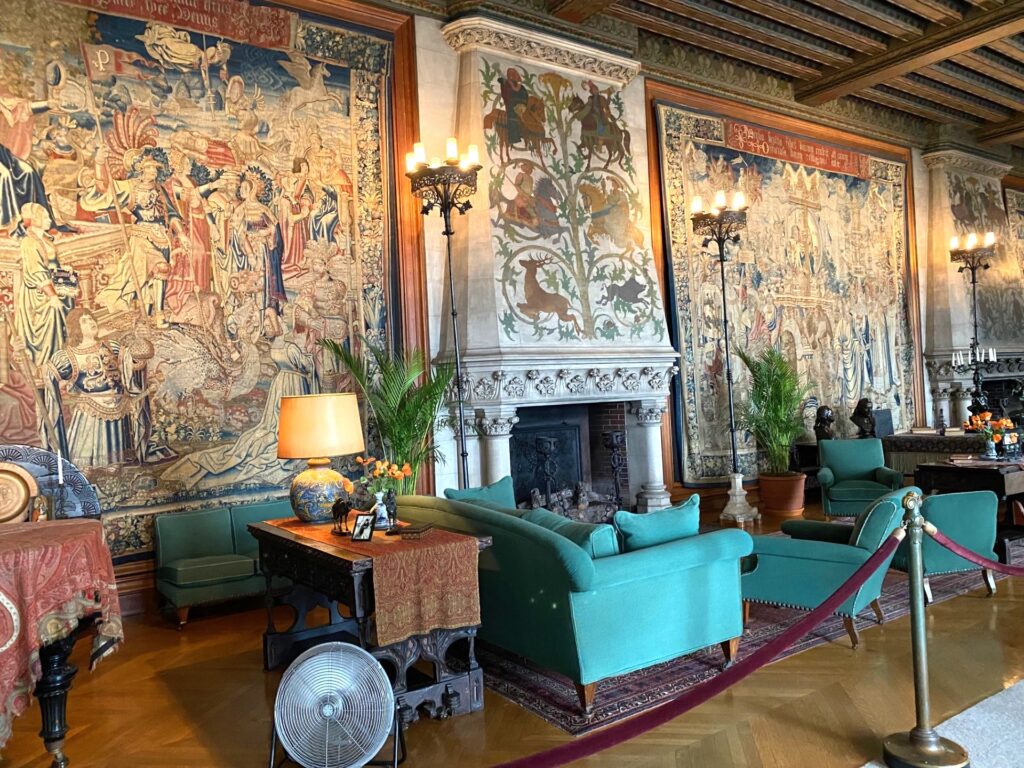 Tapestry Hallway
Tapestry Hallway
Tapestry Hall: This magnificent Hall has three tapestries known as The Triumph of the Seven Virtues. Woven from wool and silk in Flanders (now part of Belgium) in 1500’s. We learn that these illustrate how the seven virtues−faith, prudence, charity, chastity, temperance, fortitude, and justice−would always prevail over vice. We were a bit rushed on this visit. The audio has an extra explanation that points out specific details in each tapestry.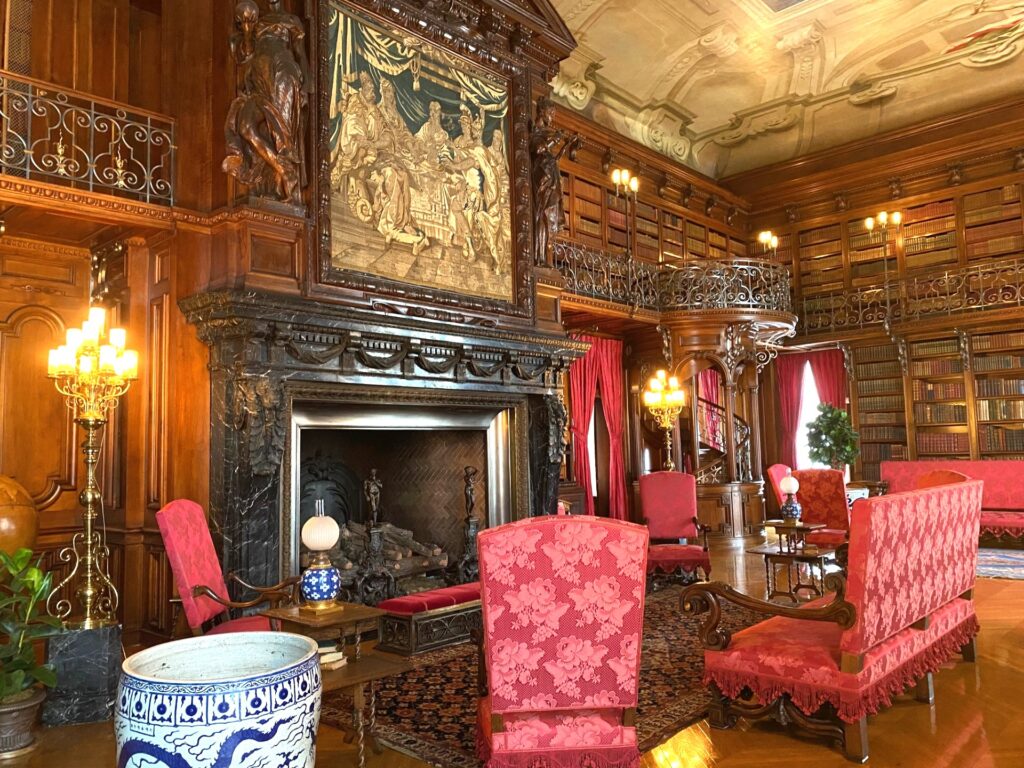 The Library
The Library
The Library: Stepping into the Library we are impressed with the volume of books in the Vanderbilt Collection. The Fireplace is huge, too. Vanderbilt was an avid reader. The walnut shelves of the Library have only half of Vanderbilt’s personal collection of 20,000 volumes.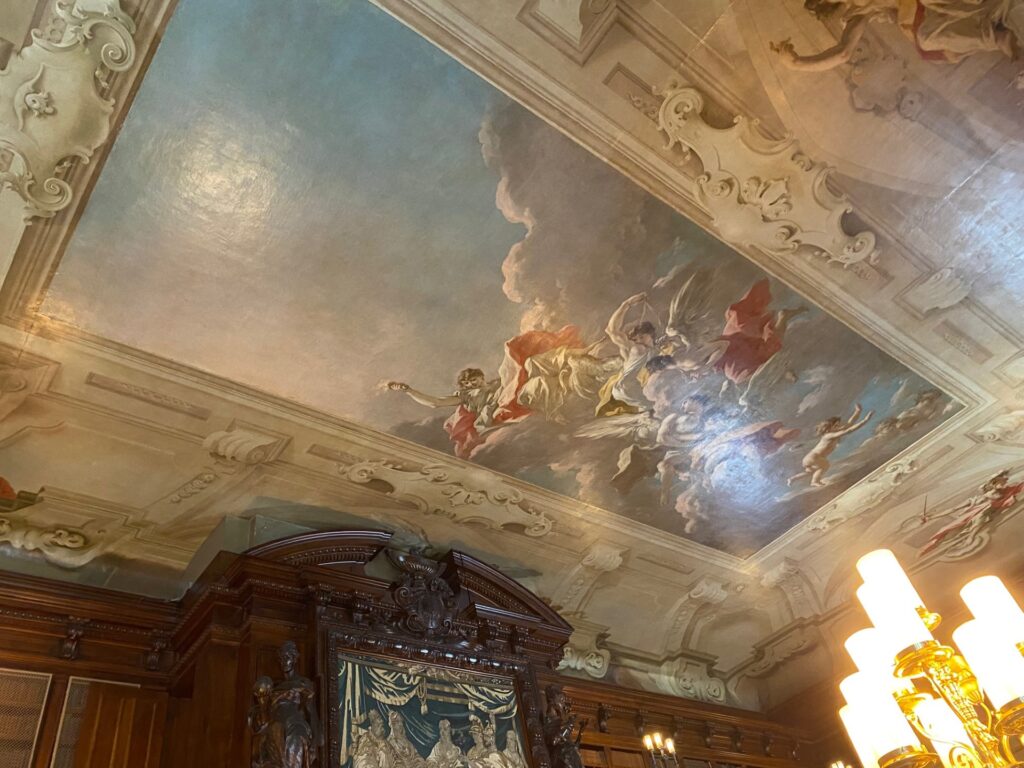 Ceiling in Library
Ceiling in Library
Ceiling of the Library: The library has a beautiful painted ceiling entitled The Chariot of Aurora. The ceiling was painted by Italian artist Giovanni Pellegrini, and it was originally in the Pisani Palace in Venice. 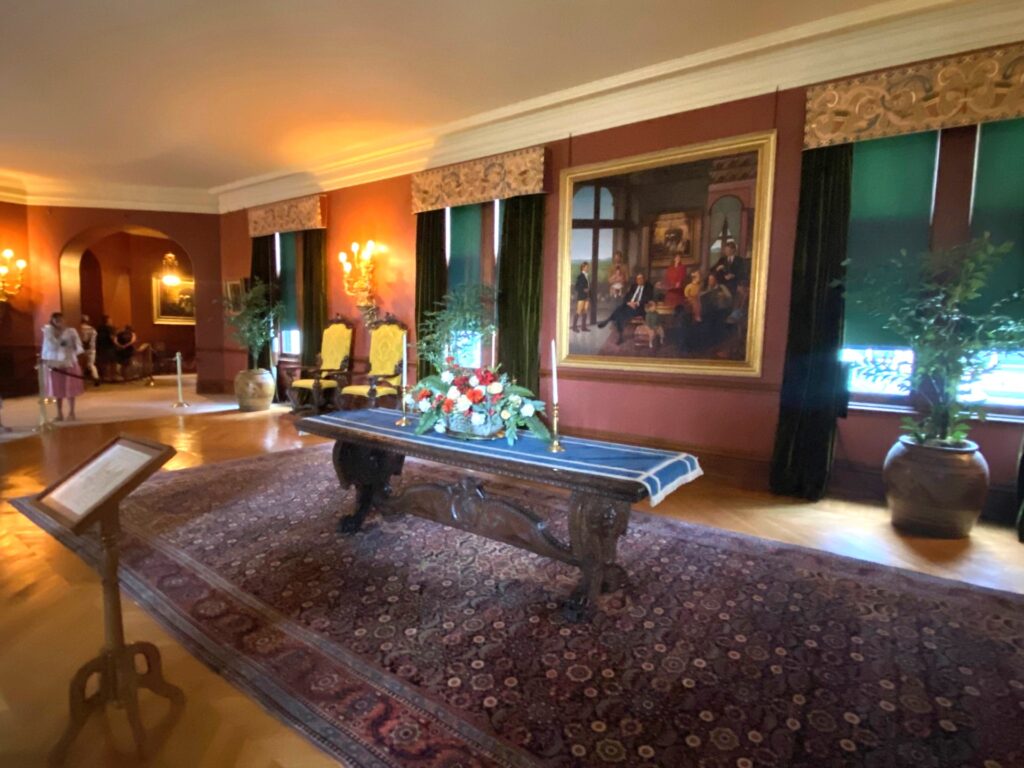 Second Floor Living Hall
Second Floor Living Hall
Second Floor Living Hall: Climbing the main staircase, we arrive on the 2nd floor. The Living Hall is a gathering place for the family. We see a more recent painting of the Vanderbilt family, as well as admire the comfort of the room. At the end of the room are paintings of two important people of the Biltmore, Frederick Law Olmstead and Richard Morris Hunt.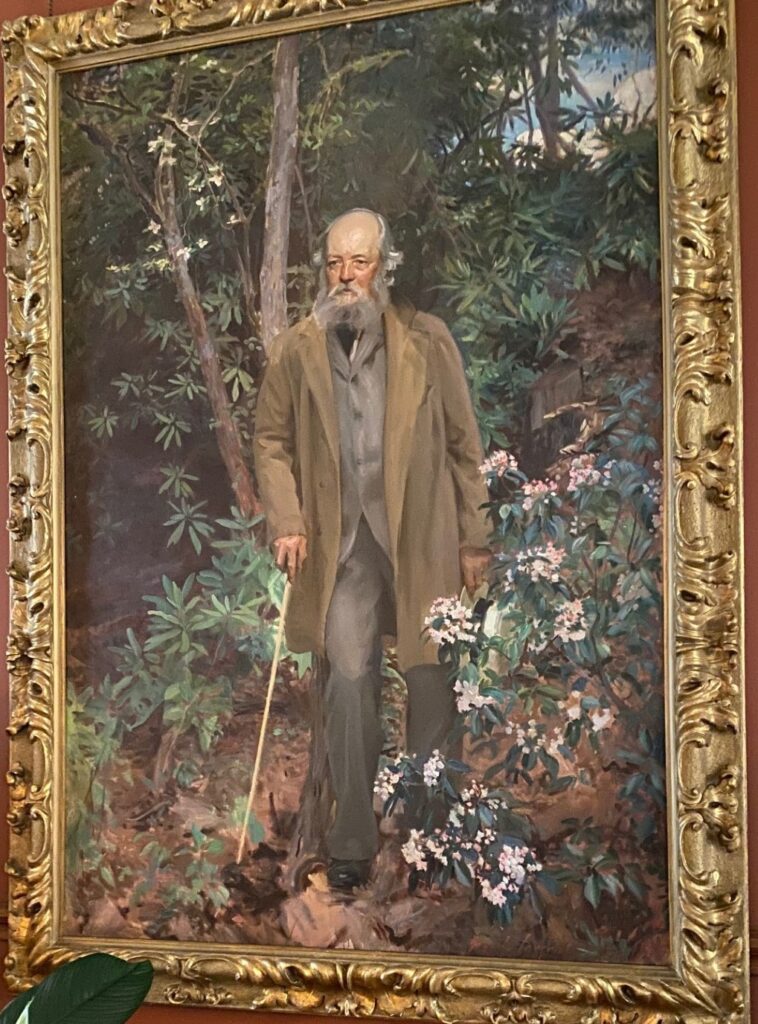 Frederick Law Olmstead, America’s most sought after landscape architect, was the landscape architect for the Biltmore.
Frederick Law Olmstead, America’s most sought after landscape architect, was the landscape architect for the Biltmore. Richard Morris Hunt was the architect that designed French Renaissance Style Chateau – The Biltmore. Hunt passed away shortly after this painting. He did not see the completion of the Biltmore House.
Richard Morris Hunt was the architect that designed French Renaissance Style Chateau – The Biltmore. Hunt passed away shortly after this painting. He did not see the completion of the Biltmore House.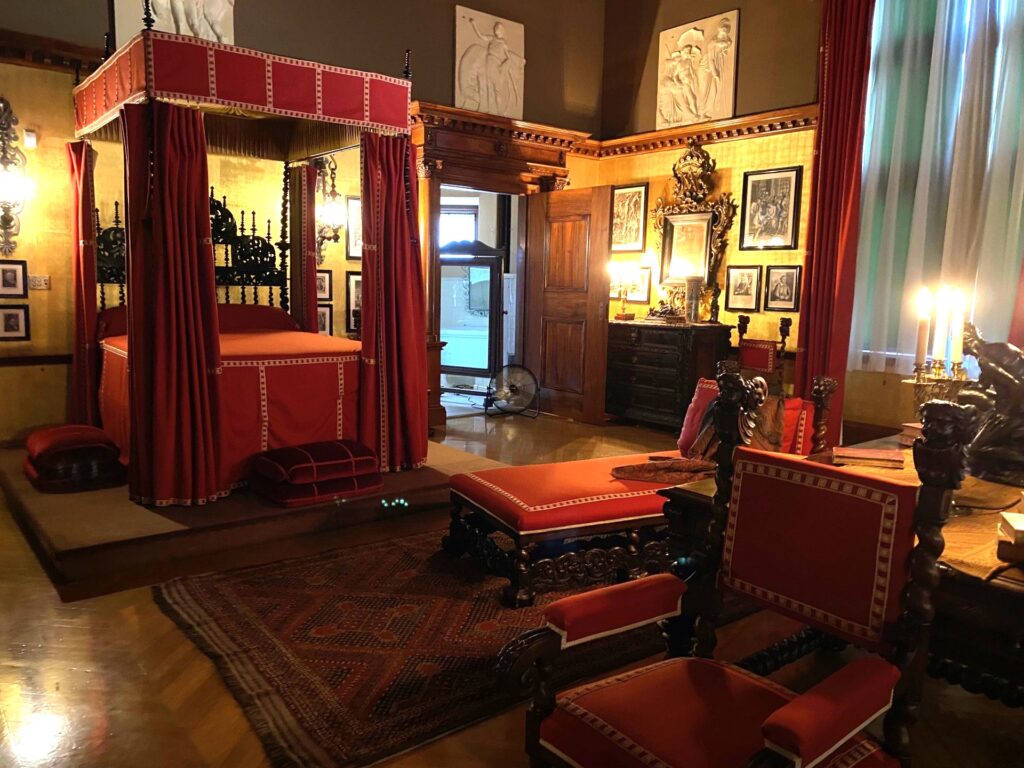 Mr. Vanderbilt’s Bedroom
Mr. Vanderbilt’s Bedroom
Mr. Vanderbilt’s Bedroom: Here we learn a bit more about George, his daily routine, his valet, etc. It is a beautiful room rich in the reds and a masculine style.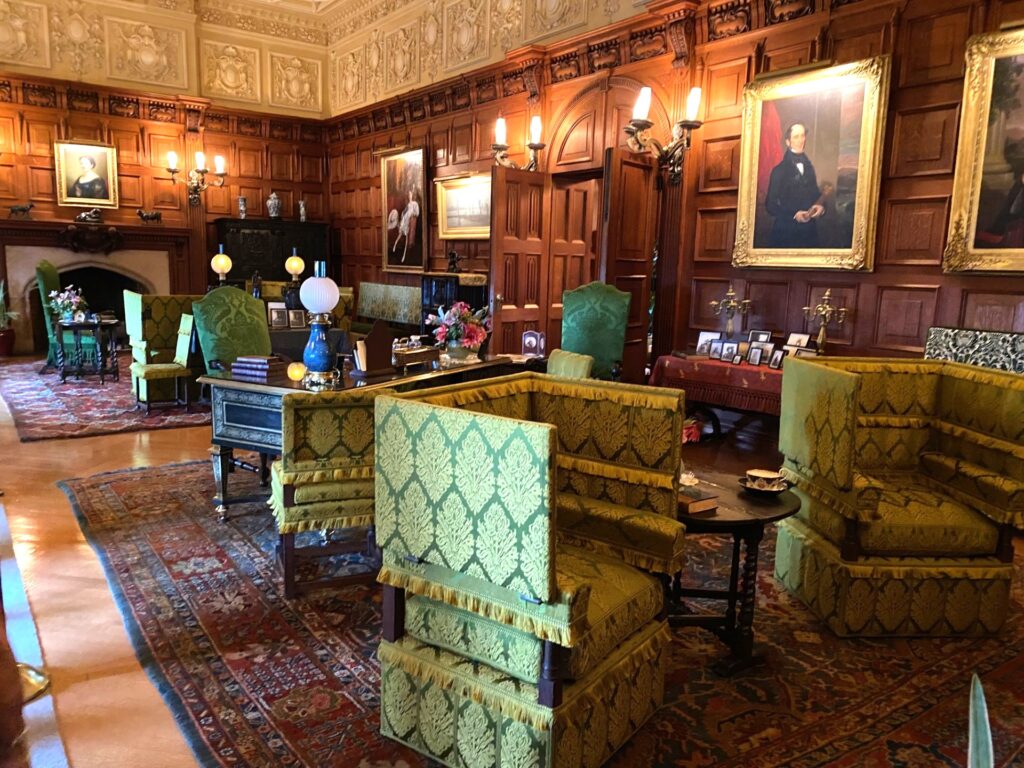 Oak Sitting Room between the Vanderbilt’s bedrooms.
Oak Sitting Room between the Vanderbilt’s bedrooms.
The Oak Sitting Room: This rooms is between Mr. & Mrs. Vanderbilt’s bedrooms. A place for them to relax between daily activities.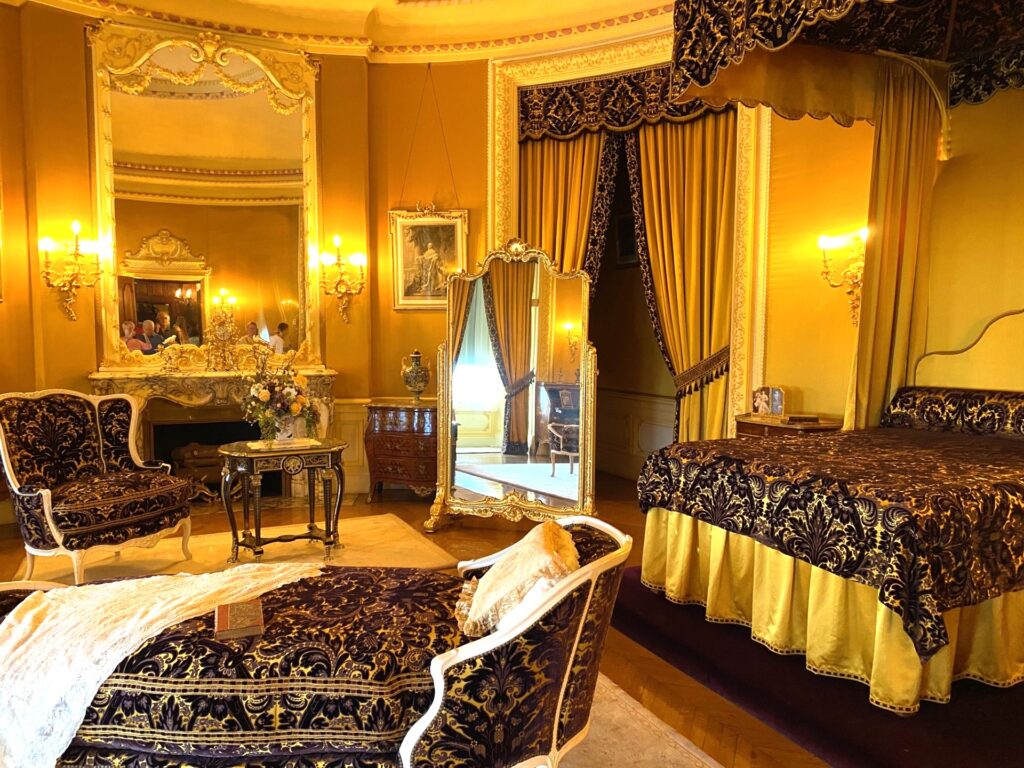 Mrs. Vanderbilt’s Bedroom and Dressing Area
Mrs. Vanderbilt’s Bedroom and Dressing Area
Mrs. Vanderbilt’s Bedroom: This room with its golden décor is beautifully decorated with these rich and vibrant colors. Mrs. Vanderbilt had an aide to assist her with dressing.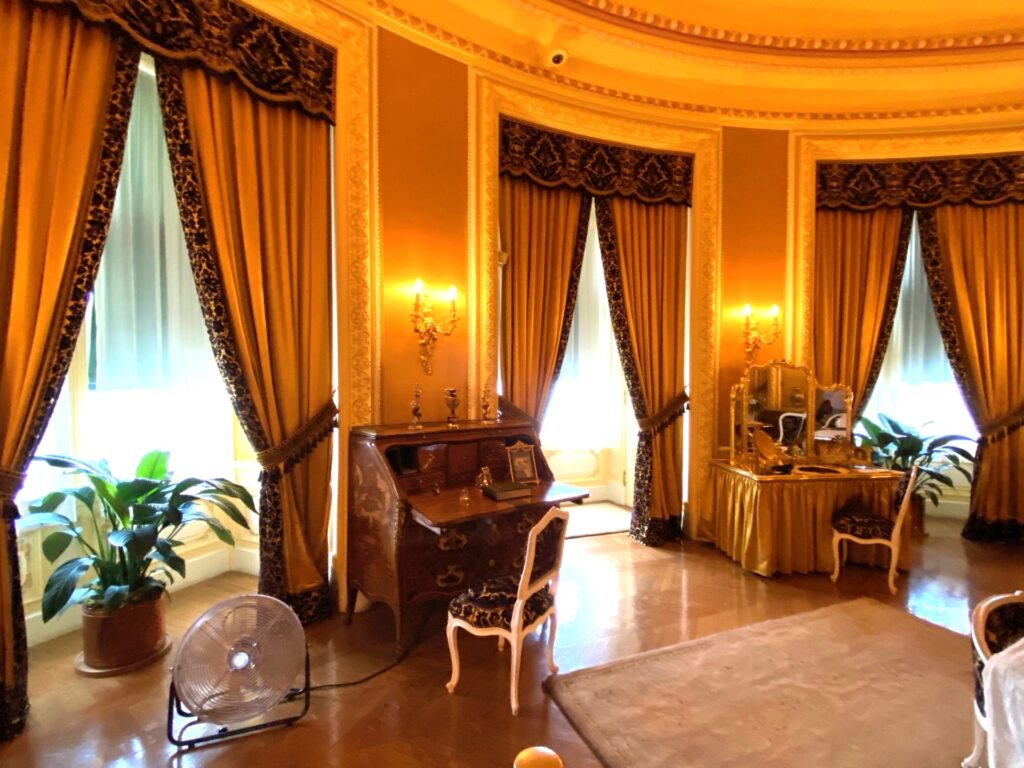 Mrs. Vanderbillt’s Bedroom
Mrs. Vanderbillt’s Bedroom
Mrs. Vanderbilt’s Bedroom – The tall windows in Mrs. Vanderbilt’s time would open up to the magnificent views of the mountains. Notice the room is circular giving it a unique style and feel.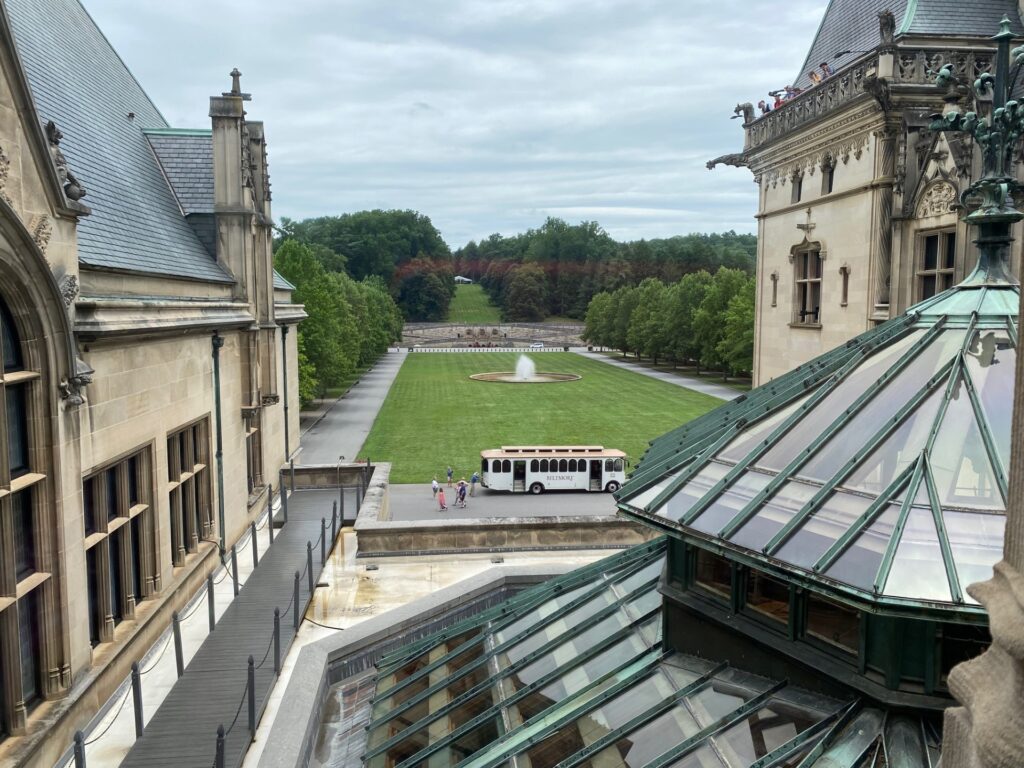 View from the second floor hallway
View from the second floor hallway
I take a few moments as we go from the second floor to the third floor to get a picture looking out from the second floor to the front lawn of Biltmore House. Third Floor Living Hall
Third Floor Living Hall
Third Floor Living Hall: After climbing the stairs to the third floor, we see the warm rich style of this Living Hall. Guests stayed on the third floor, so this area was a place for them to gather and relax.
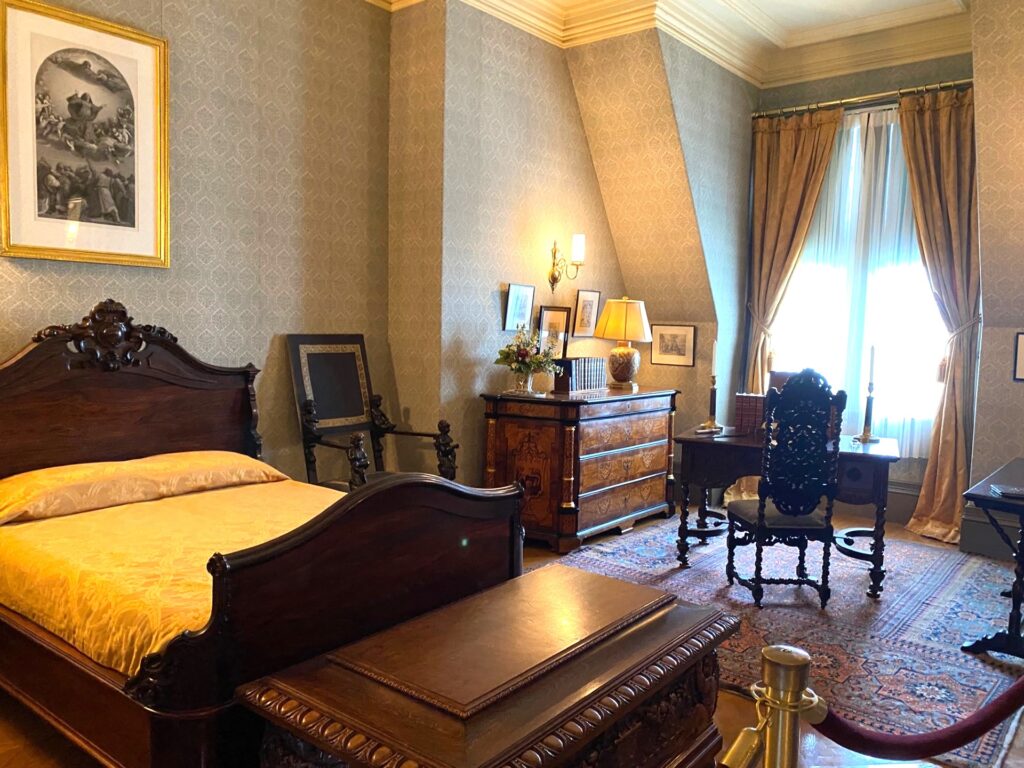 Guest Bedroom
Guest Bedroom
Guest and Artists Rooms: On the 3rd floor the tour takes us through a few guest and artists rooms. All is well done but not as fancy or plush as the Vanderbilt’s personal bedrooms.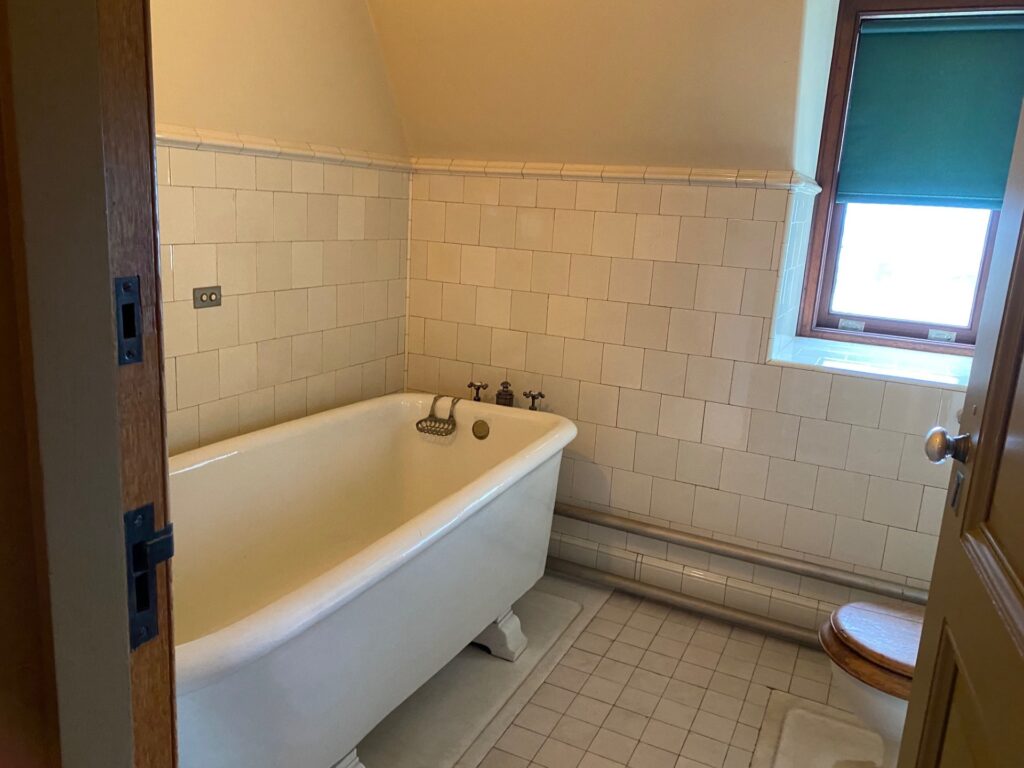 Guest Private Bathroom
Guest Private Bathroom
Guest Room Private Bathroom: A unique feature of all the Guest Rooms at the Biltmore was that each Guest Room had it’s own bathroom. Yes, complete with running water, this was truly a luxury in the late 1900’s.
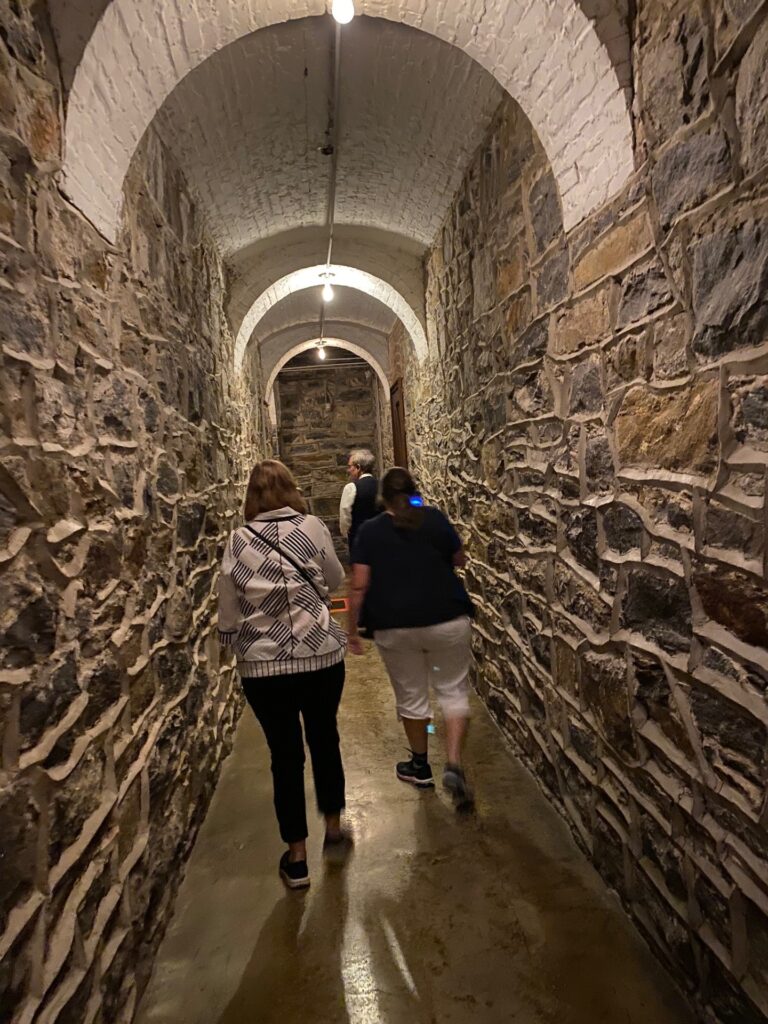 Hallway to basement
Hallway to basement
It’s a good walk down the backstairs from the 3rd floor to the basement at Biltmore House. We go from luxury to the rough walls of the basement.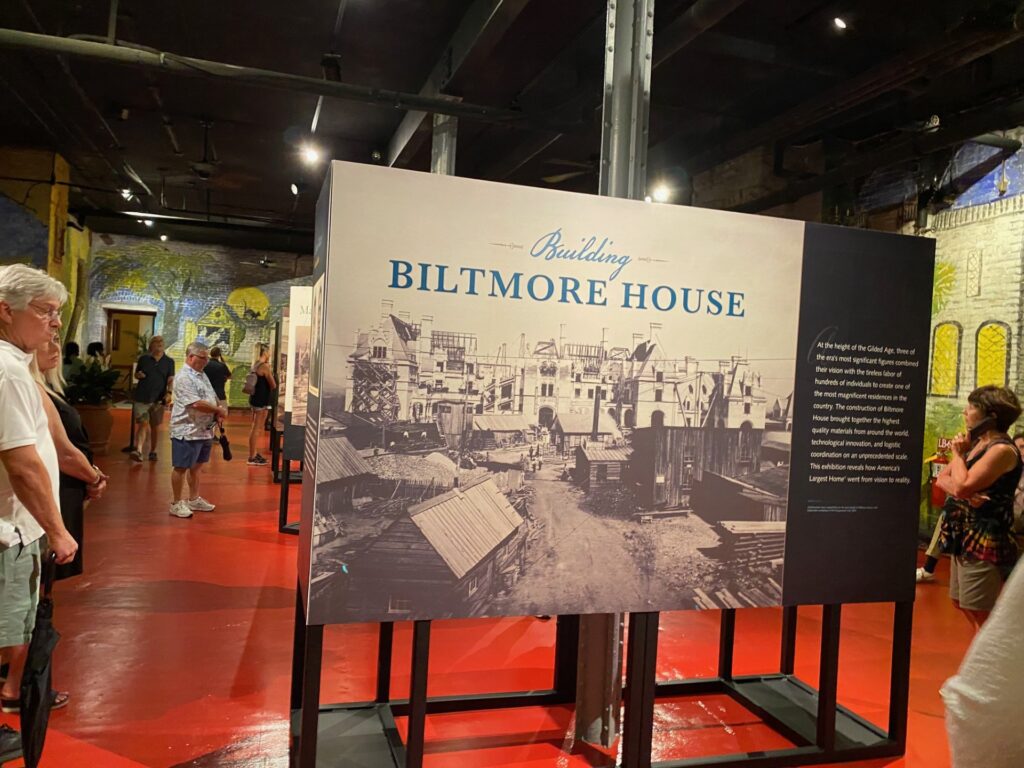 Basement Halloween Room or New Year’s Eve Room?
Basement Halloween Room or New Year’s Eve Room?
The Halloween Room or the 1925 New Year’s Eve Celebration Room: On prior visits to the Biltmore this cavernous room with its brightly-colored murals of an array of creatures was named the Halloween Room. Today, it is used to provide a more in-depth history of the workers involved in the construction of the Biltmore.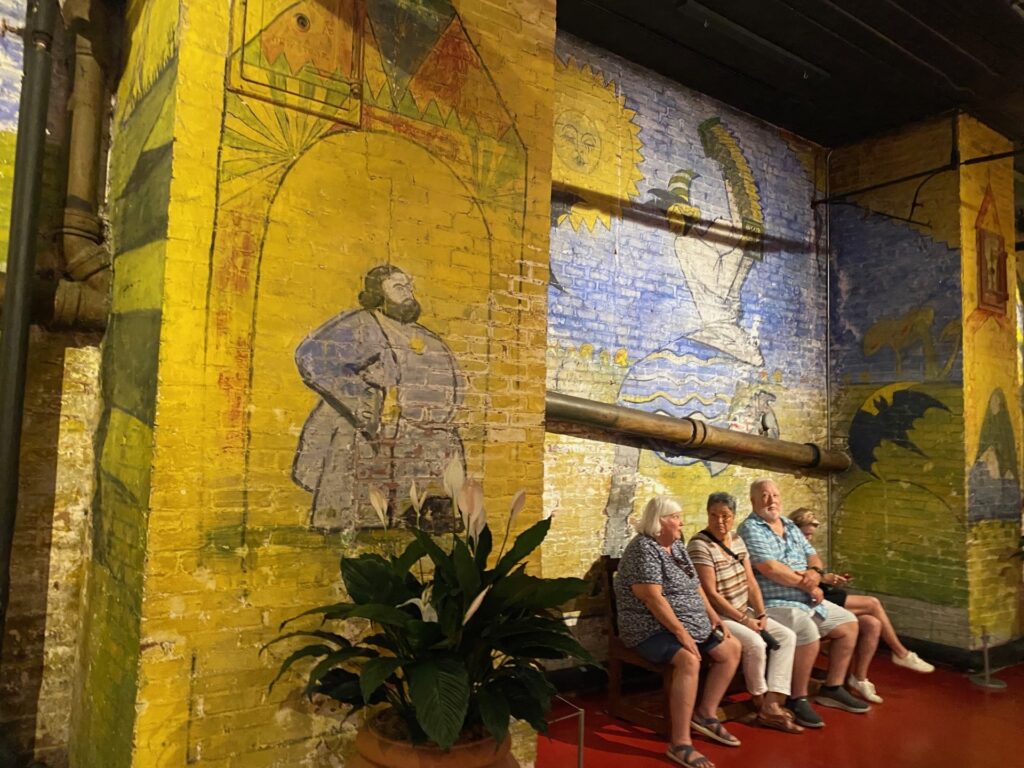 The unusual painted walls of the carernous basement.
The unusual painted walls of the carernous basement.
Further research now shows it was actually created in December 1925 to prepare for the New Year’s Eve Celebration. These are extravagant and bizarre paintings for this New Year’s Eve Party.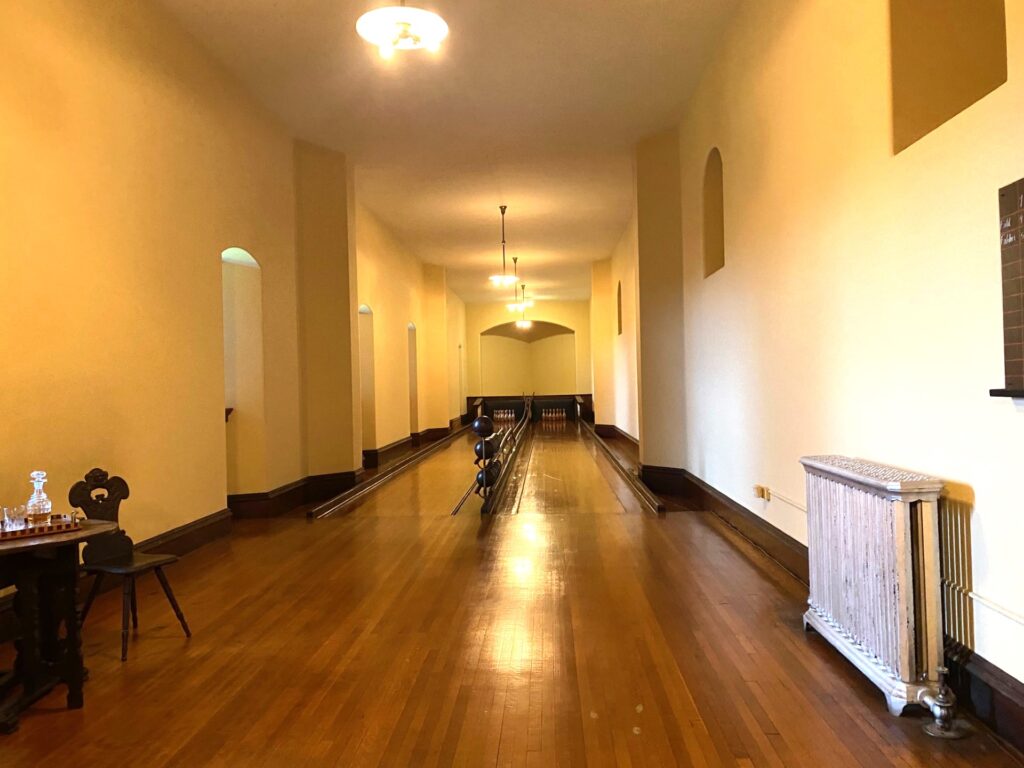 Bowling Alley
Bowling Alley
The Bowling Alley: the Vanderbilt’s provided guests with a variety of activities. In the basement we find the bowling alley. This was before the time of automatic pin resets. Instead, staff were required to reset the pins. It is pretty tight in those quarters. After the Bowling Alley, we pass the Ladies Dressing Rooms along with various Workout Rooms. Ooops, didn’t get pictures of these.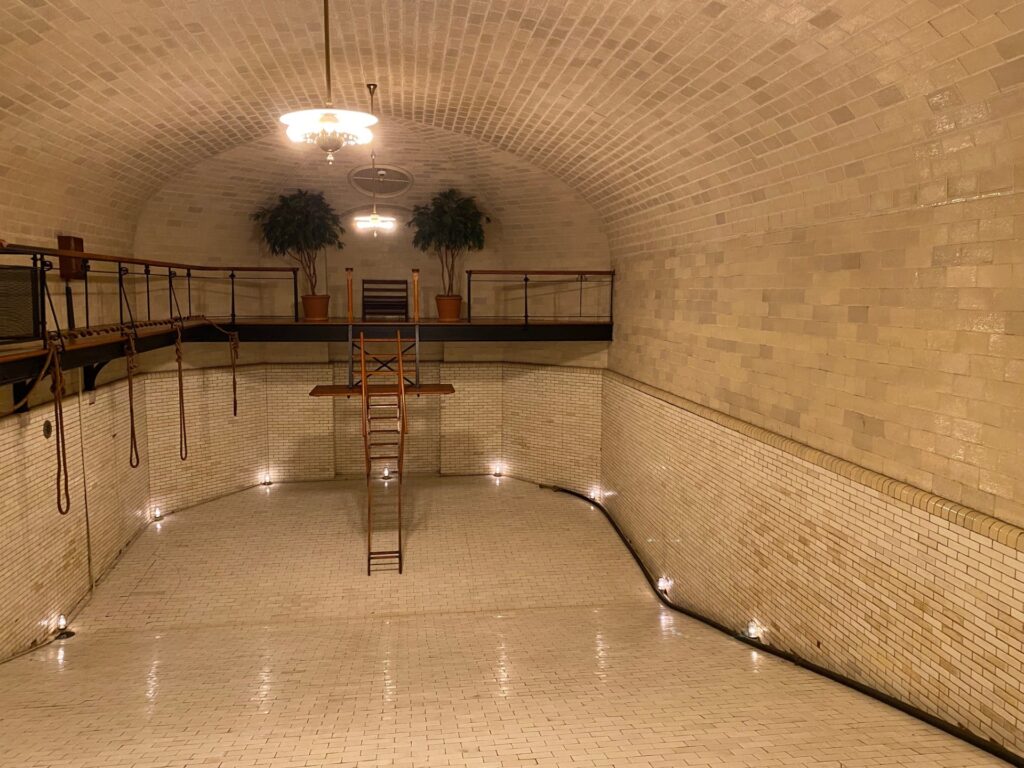 Swimming Pool
Swimming Pool
The Indoor Swimming Pool: An indoor swimming pool was a unique feature of the Biltmore. The tile work and especially the arched tile work at the Biltmore was done by Spanish architect Raphael Guastavino. He was renowned for creating grand arches, domes, and vaults in Europe. Guastavino also did dome of the St. Lawrence Basilica in Asheville. Note: The pool had to be emptied and cleaned after each use. The ropes along the side are for guests to grasp, as many guests could not swim.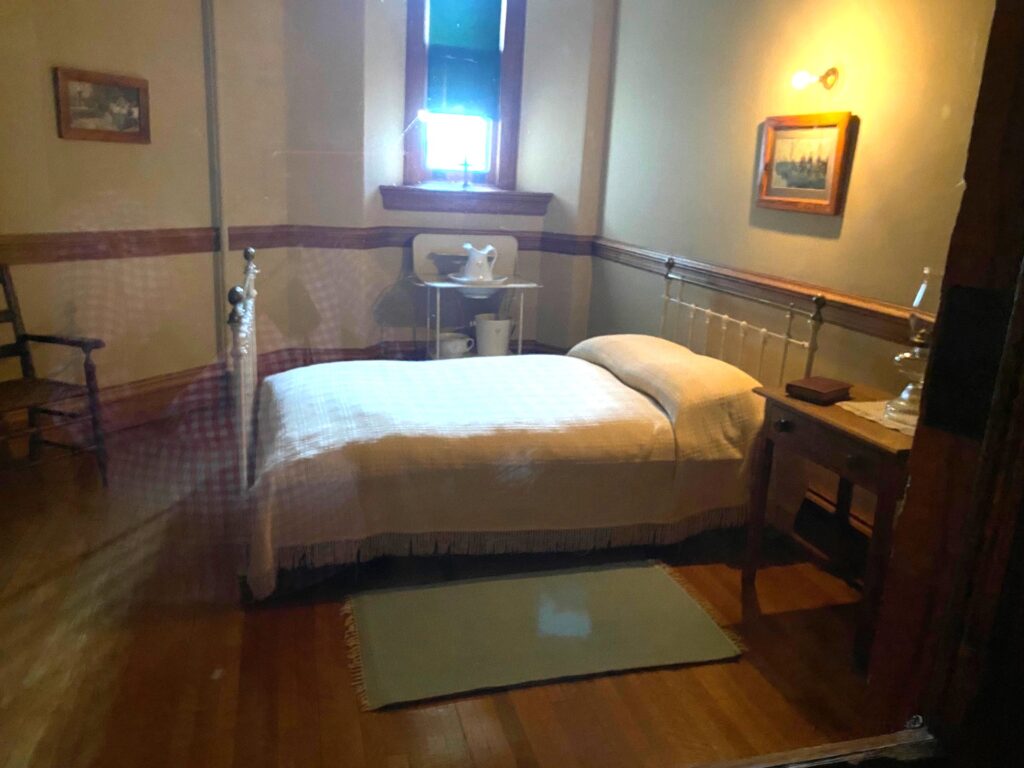 Female Servant Room
Female Servant Room
Servants Quarters: As we continue the tour in the basement area, we arrive at the Servant’s Quarters. Each servant had a small room. The female servants were usually in the basement while the male servants were in the top floors of the house. They worked long shifts each day.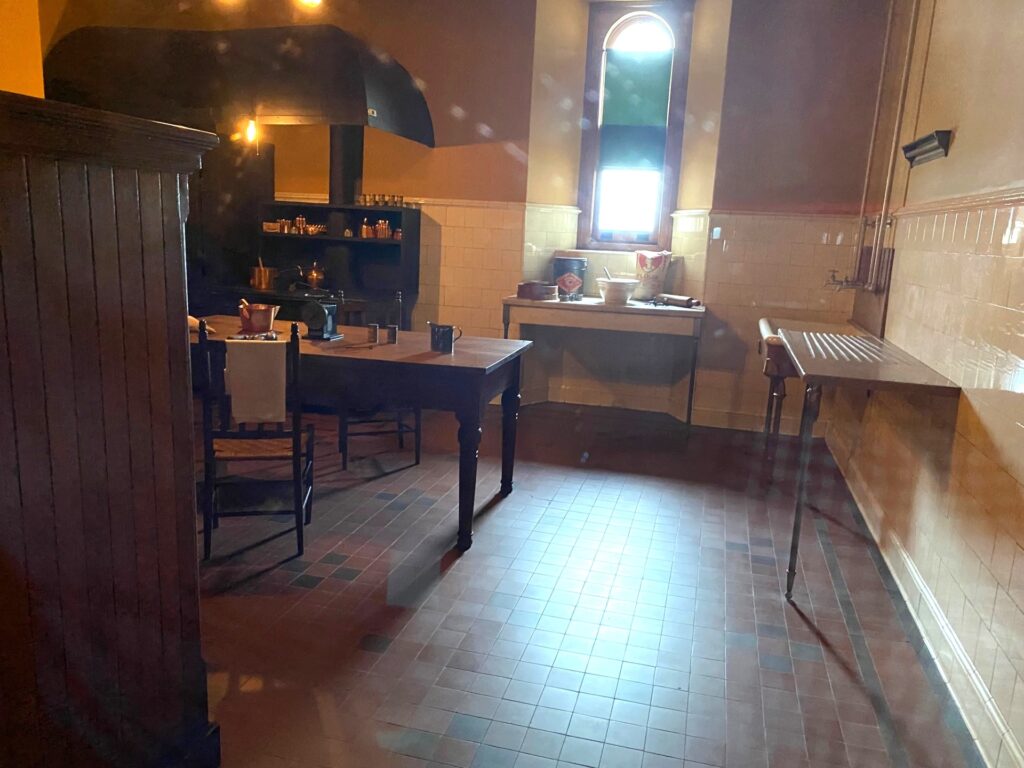 Kitchen area
Kitchen area
Cooking areas of the Biltmore. We see the various cooking areas and storage areas necessary for running a house this size. There is a prep kitchen, a Rotisserie Kitchen, numerous areas of storage from dairy items to canned goods and more. We can peep into these areas as we walk the hallways. We imagine the daily hustle and bustle of food preparations for the family and guests.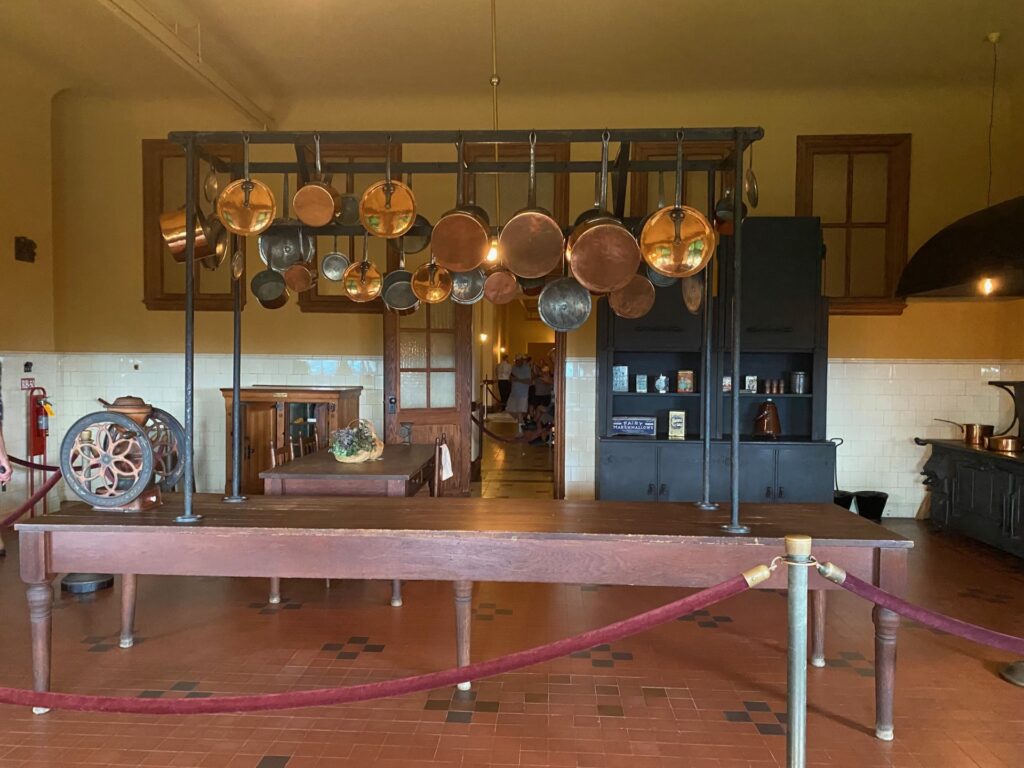 Main Kitchen
Main Kitchen
The Kitchen: This kitchen is sparkling now but it would be full of activity each day for the various meals.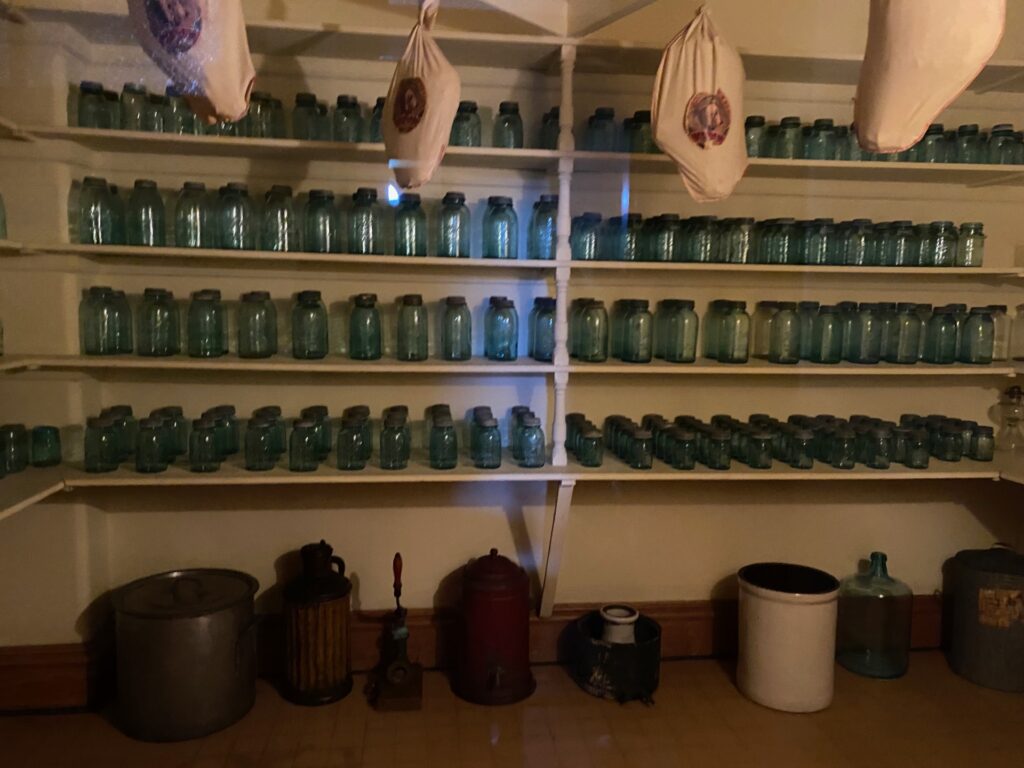 Canning area
Canning area
Canning supplies: Certain seasons were busy with canning fruits and vegetables. Notice the hams hanging from the ceiling. I grew up in the mountains of Virginia and remember my grandparents doing this. It is Salt Curing the Ham to prevent spoiling and extends the life of the ham. Hanging hams in a cool, dry place helps to preserve the meat by allowing it to dry out and cure over time.
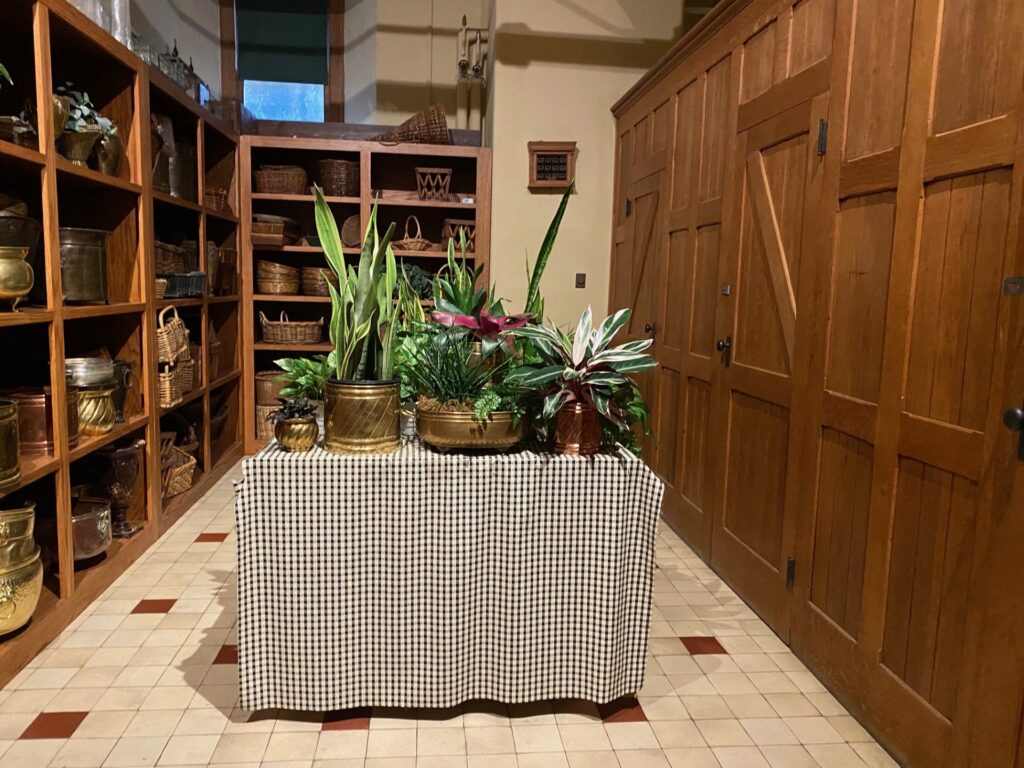 Floral arrangment area
Floral arrangment area
Flower decorations and Plants for the Biltmore House: This massive house required a lot of plants and florals to provide a well-kept appearance. As we toured the house, we notice the many floral arrangements in the rooms. Kitchen Pantry
Kitchen Pantry
The Kitchen Pantry: Here we see the display of some of the china used at the Biltmore House. It took a lot of people to prepare the numerous meals for family and guests. We also learn about and see the dumb waiters used to get food from the kitchen to the Banquet Hall or Breakfast Room.
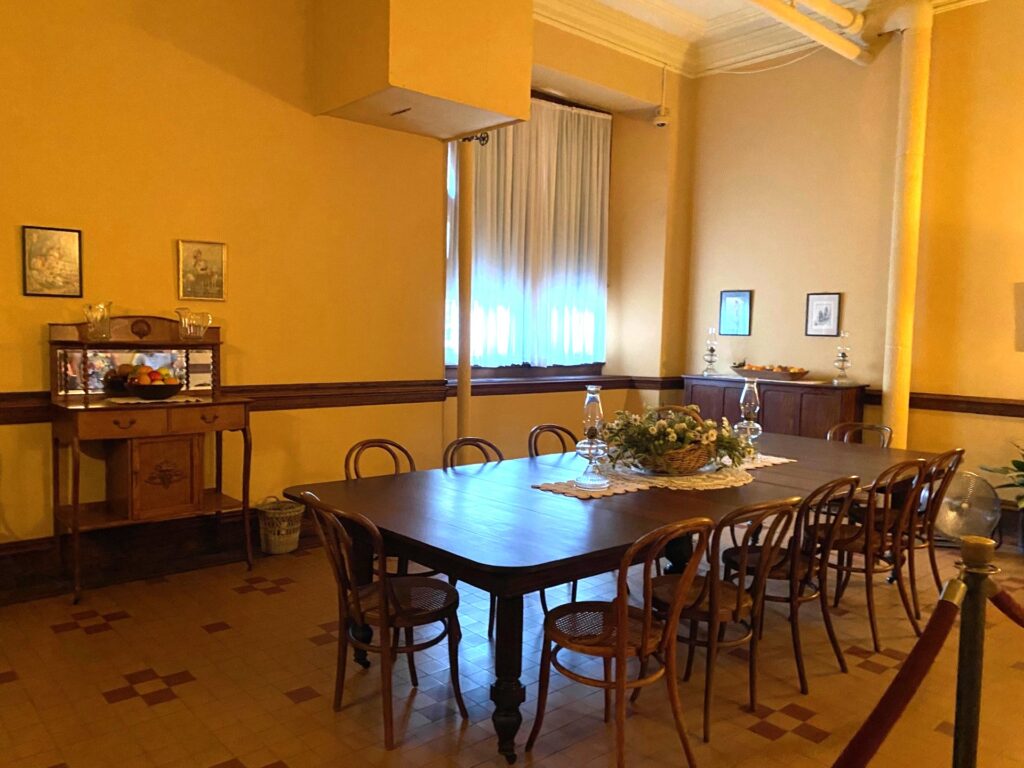 Servant’s Dining Room
Servant’s Dining Room
The Servant’s Dining Room: Any Downtown Abbey fan, easily recognizes the Servant’s Dining Room, where Mr. Carter, the Butler, would dine with the staff. Umm! Assume there were a lot of interesting conversations at the dining table.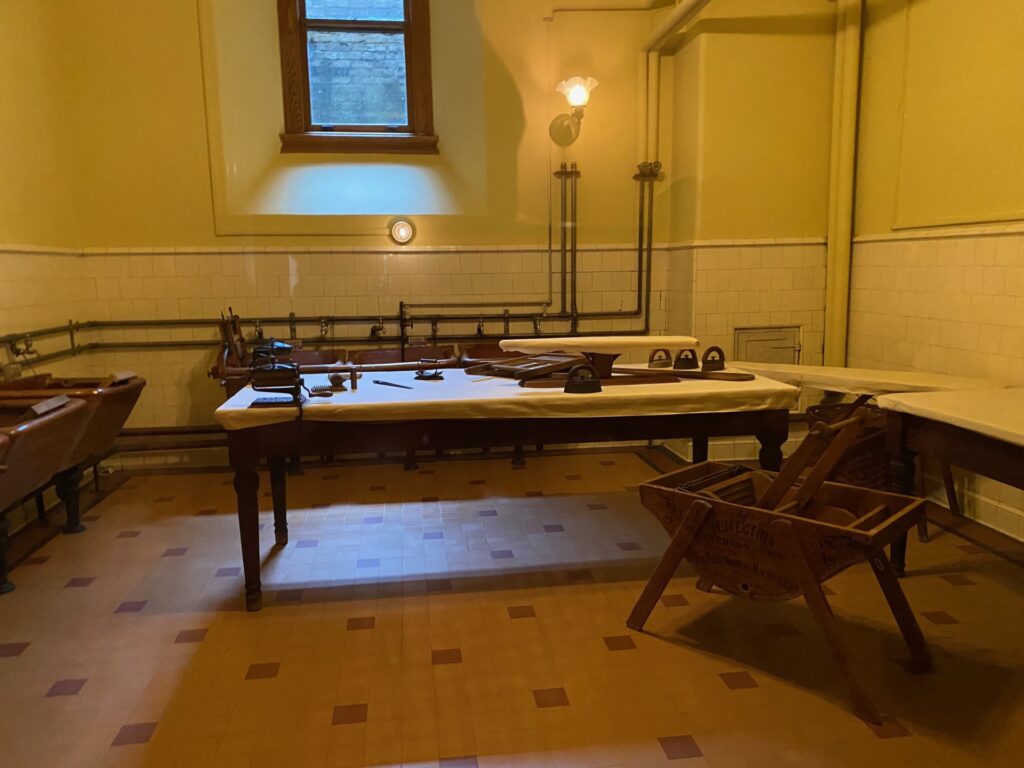 Laundry area
Laundry area
The Laundry area: It’s a full time job just handling the laundry for this huge house. Between clothing for family and guests, it kept the staff busy with laundry.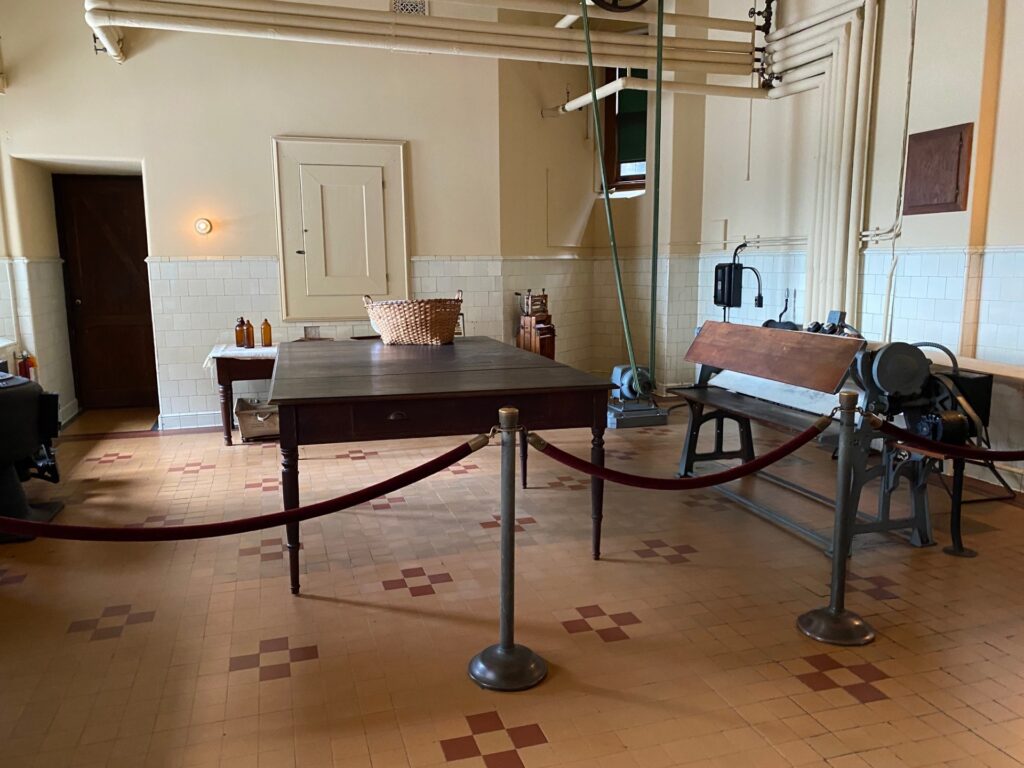 Main Laundry
Main Laundry
The Main Laundry: With 33 bedrooms, 45 bathrooms, linens for dining, and other items, the staff were constantly doing laundry. There are large drying rooms off the Main Laundry.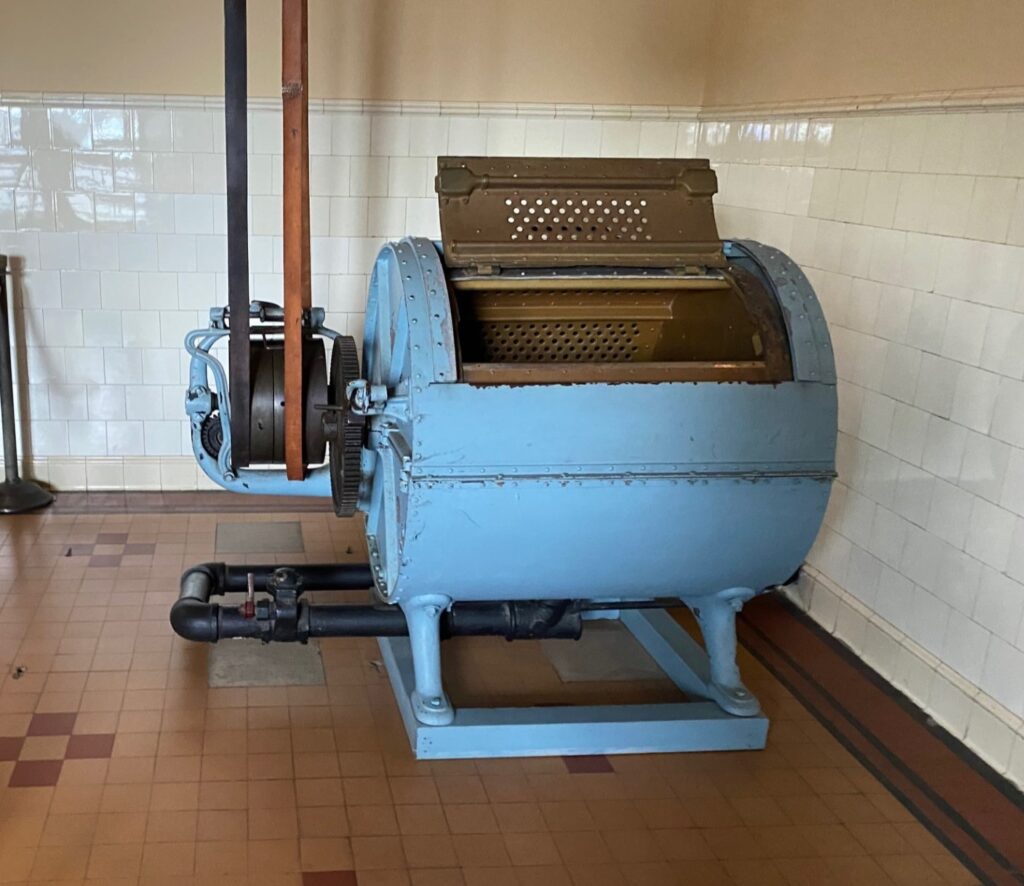 Washing Machine in Laundry
Washing Machine in Laundry
This is a sophisticated washing machine for its time. Look at the belts that provide the agitation.
Following the audio-guide and signs, we wind our way back upstairs. For our final stops on the tour, the rooms are under renovation so we don’t get to see them staged for the era. Wow! The audio-tour is great! The Biltmore House is most impressive and we gain insight into life in the Gilded Age. With our stops and taking time to appreciate each stop on the tour and a few other areas, it takes us around 90 minutes. Now to check out Antler Village. As we stroll back through Walled Garden, Rose Garden and Conservatory, we stop for a few extra pictures. It is nice slow drive the five miles from the Conservatory to Antler Village. We see fields planted with a variety of crops.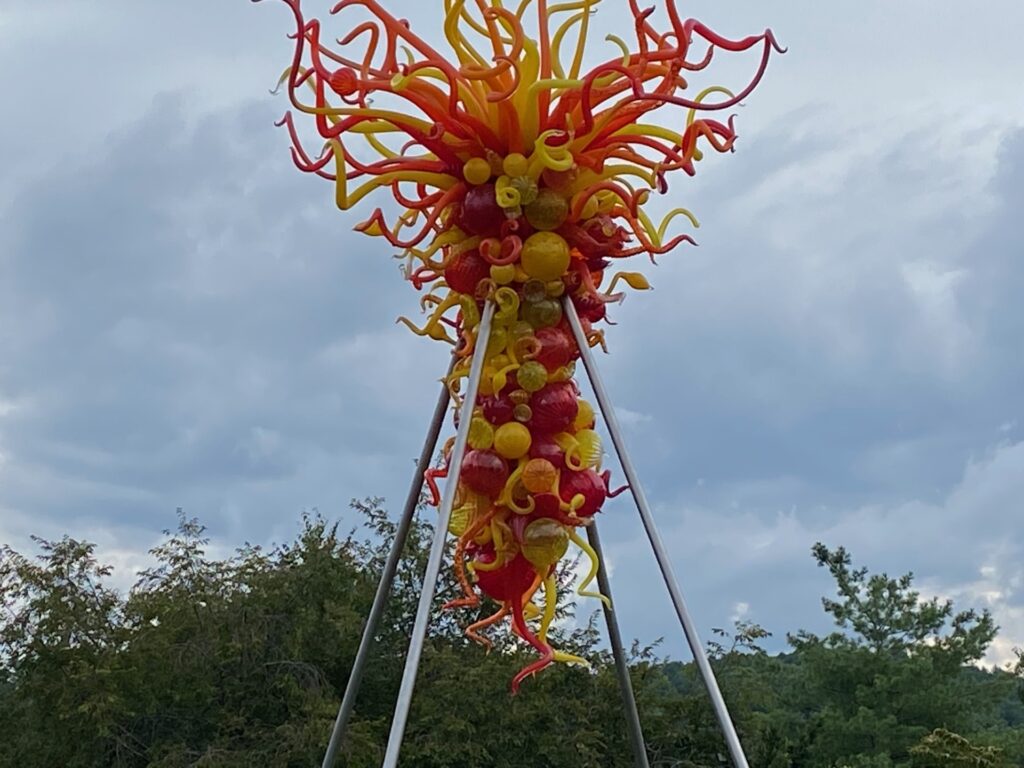 Torchlight Chandelier by Dale Chihuly
Torchlight Chandelier by Dale Chihuly
ANTLER VILLAGE
We easily find a parking space at Antler Village and are ready for a late lunch. Walking by the Village Green, we stop for a photo of another of Dale Chihuly’s glass designs. Currently, the Biltmore has Chihuly at Biltmore, a display in Ameherst at Deer Park featuring the iconic works by the world-renowned artist Dale Chihuly. While we didn’t purchase tickets for this exhibition, we were thrilled to see some of his work at the House and Antler Village. We enjoy a late lunch on the Patio at Cedric’s Tavern. Cedric was the beloved St. Bernard of the Vanderbilt’s. With it being later in the day after 4:00PM, we decide to just go to The Biltmore Legacy and the Winery. While we didn’t visit this time, we highly recommend a visit to the FARM. This has the Antler Hill Barn, the Farmyard Pisgah Playground. Plenty of activities and things to do at the FARM.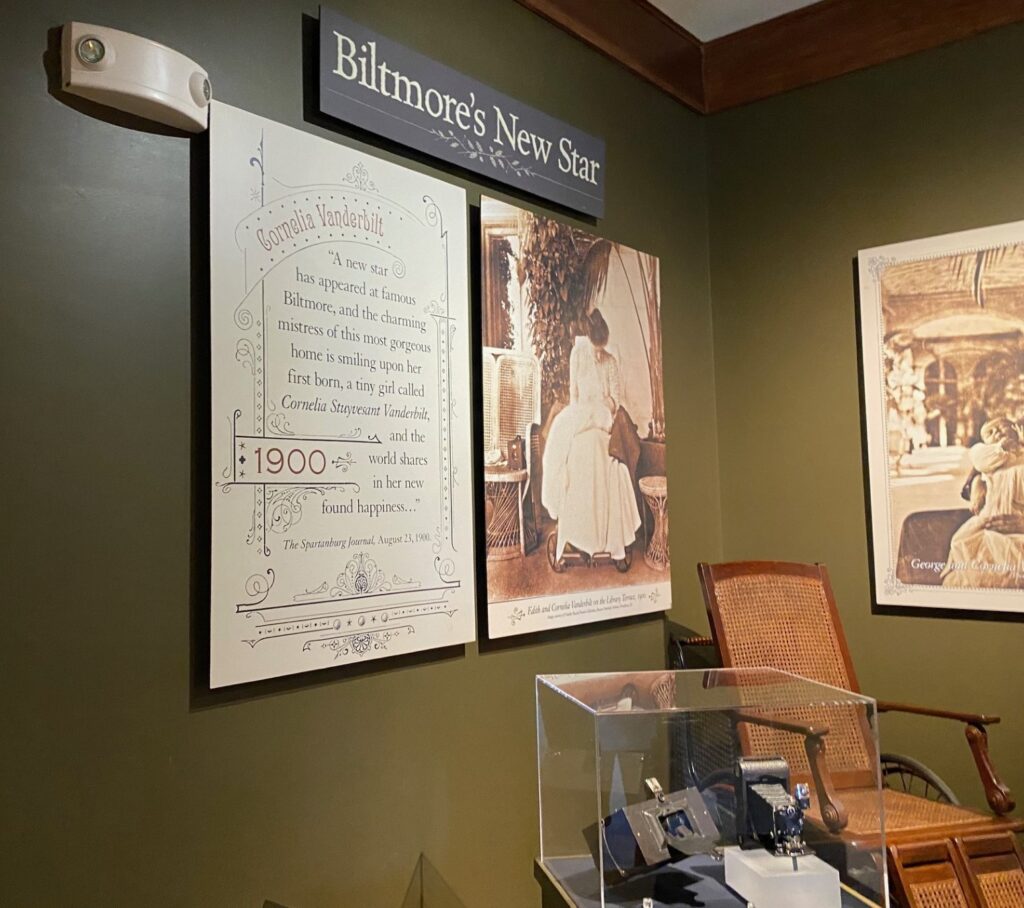 Photograph of Cornelia Vanderbilt, The Vanderbilt’s Daughter “Biltmore’s New Star!”
Photograph of Cornelia Vanderbilt, The Vanderbilt’s Daughter “Biltmore’s New Star!”
THE BILTMORE LEGACY
At The Biltmore Legacy, we learn details about George Vanderbilt, his wife Edith, their only child, Cornelia and the legacy of the family from then to today. George Vanderbilt, the son of Cornelius Vanderbilt, inherited his money from his father. Cornelius was an American business magnate who built his wealth in railroads and shipping. As the youngest son, George was considered “America’s most eligible bachelor.” Touring the Legacy Exhibits, we learn about the numerous travels of George Vanderbilt, his passion for acquiring artwork, etc. and reading. He was a well-traveled individual, with over 60 crossings of the Atlantic and visited over 24 countries. We gain insight into his marriage to Edith, their daughter Cornelia and his untimely death. The Legacy shares the challenges of the Biltmore at the decline of the Gilda Age, and the family’s dedication to maintain the Estate. Thanks to that dedication we have the wonderful Biltmore Estate today that allows visitors to gain a glimpse into the life of the Gilda Age.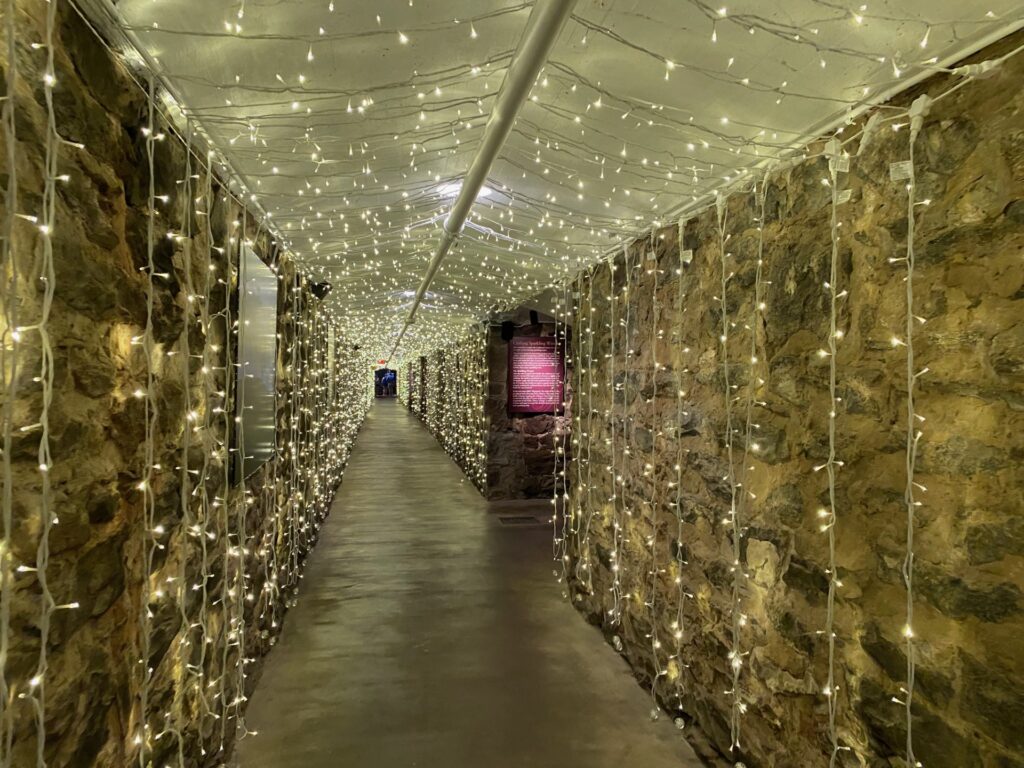 Walk the long tu;nnel to the Wine Tasting
Walk the long tu;nnel to the Wine Tasting
THE WINERY
Cheers! We are ready to do some wine tasting at the Biltmore Winery. Housed in the former Dairy, we enjoy the cool walk through the tunnel of lights. We stop to read signs of the history of Vanderbilt’s interest in wine making. There are various rooms where wine is being aged. On prior visits, a Wine Tour was included with the ticket. Today, it is a self-tour that ends at the Wine Tasting Room, Wine Bar and Wine Shop. The Wine Tasting is included in the ticket. Today, it is packed. Guests are lined up for the complementary wine tasting. Chatting with others in line, the 20 minute wait isn’t bad.
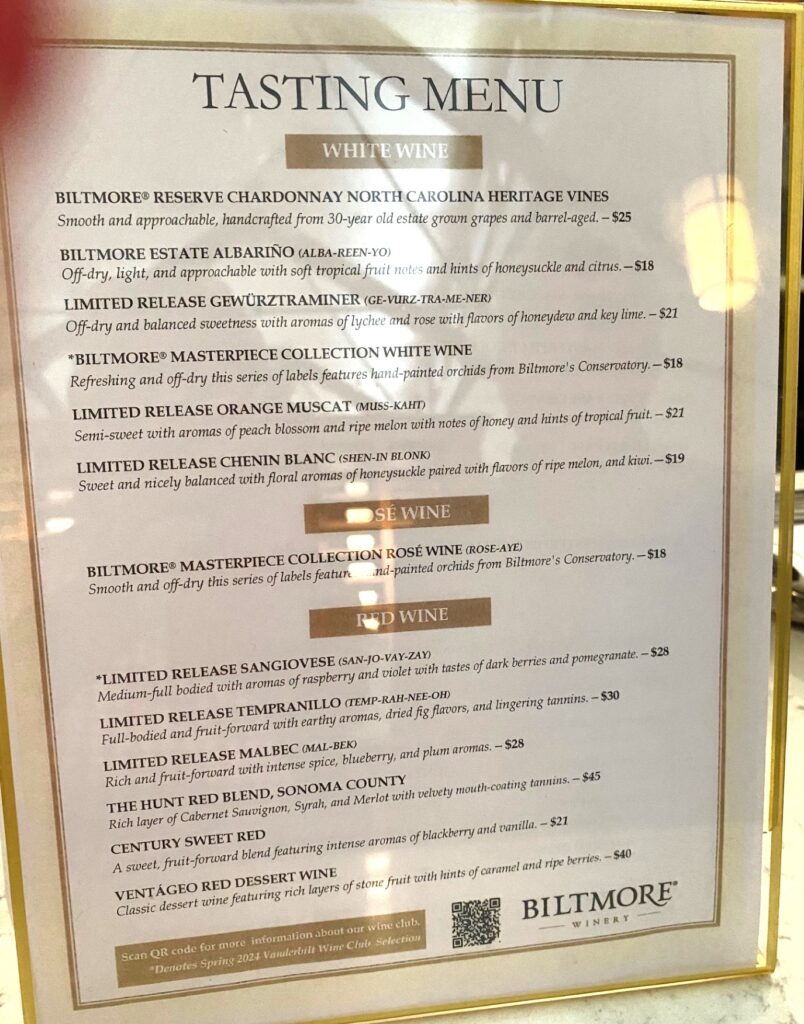 The Wine Tasting Menu
The Wine Tasting Menu
We take our time tasting the wines. We each get to sample five wines. Checking out the options, we try different ones, sharing so we actually sample ten wines. Preferring Chardonnay, we were very impressed with their Biltmore Reserve Chardonnay. Other wines were very good and we also liked the Ventageo Red Dessert Wine. After the wine tasting we check out the wine store and leave with bottles of our favorite wines. A wonderful finish to our day at the Biltmore.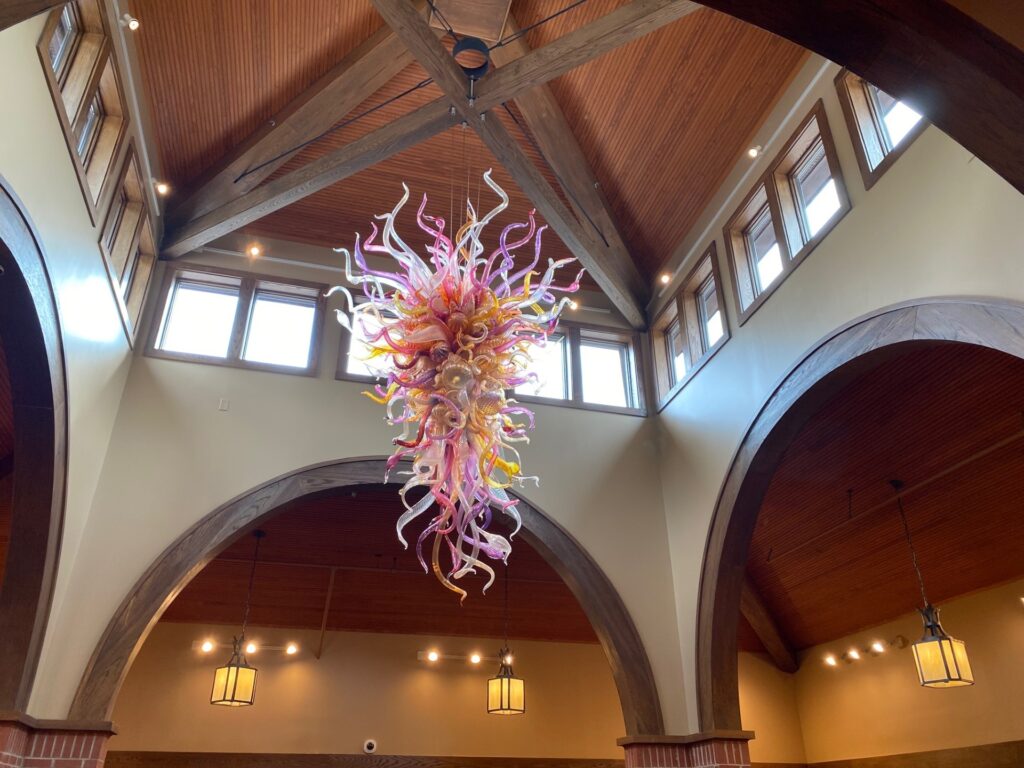 Iris Gold and Garnet Chandelier by Dale Chihuly
Iris Gold and Garnet Chandelier by Dale Chihuly
The beautiful glass chandelier by Chihuly hangs from the ceiling of the Wine Shop.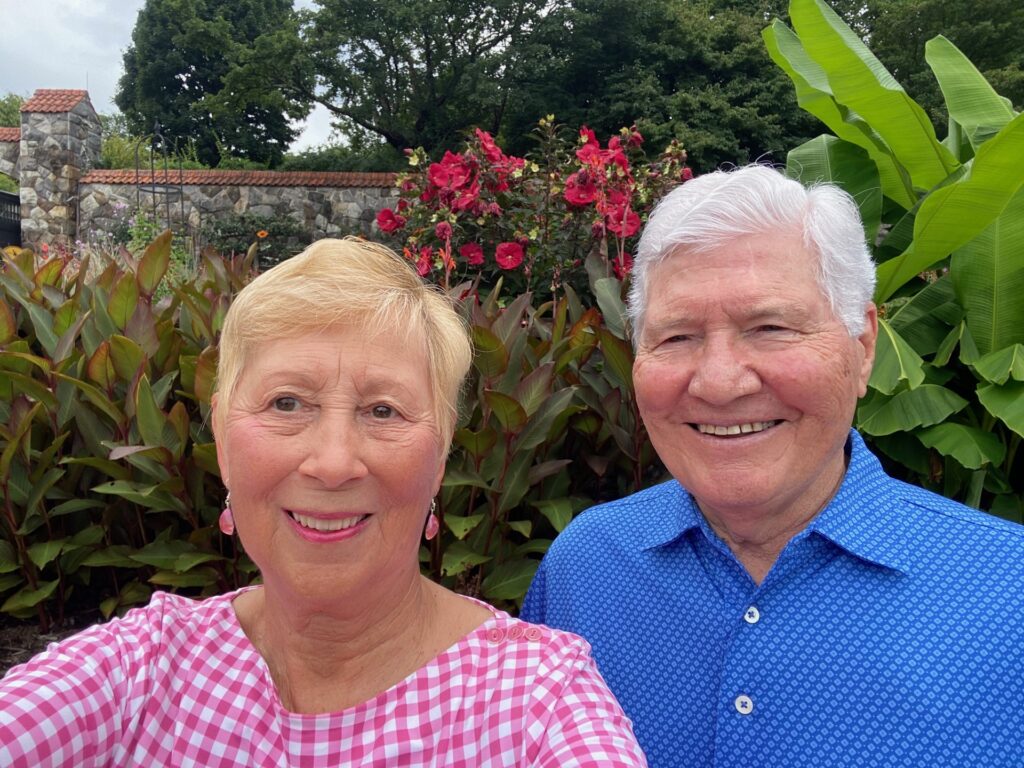 The Mixa’s in the Walled Garden
The Mixa’s in the Walled Garden
SO WHAT’S THE BIG DEAL ABOUT THE BILTMORE?
On a visit in California after touring the Hearst Castle, I was asked, “Which place do you like the best – Biltmore or Hearst Castle? “Definitely, the Biltmore!” The Vanderbilt’s had a major impact on the city of Asheville and the surrounding area. While Hearst Castle, was just a huge home of a rich man that did very little for town of San Simeon, California. On our first visit to Hearst Castle there was basically nothing to see but the Castle. The Biltmore is still family-owned and continues to be operated under George Vanderbilt’s mission of “preservation” through self-sufficiency. Let’s look at the impact the Biltmore Estate had on Asheville and North Carolina.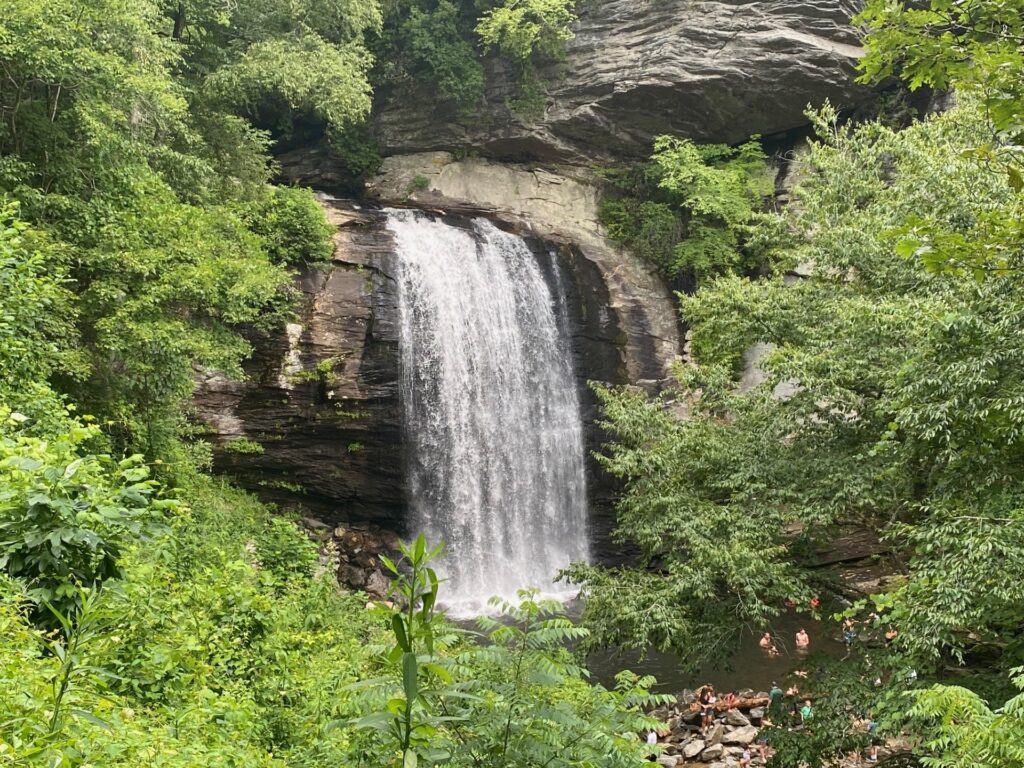 The magnificent Looking Glass Falls in Pisgah National Forest
The magnificent Looking Glass Falls in Pisgah National Forest
- George Vanderbilt wanted the Biltmore to be more than a beautiful home. He wanted it to be a productive investment. The Biltmore produced profiting commodities of cattle, grain, honey, butter, and timber.
- Vanderbilt utilized innovative farm techniques that helped Biltmore be successful in farming.
- In 1889, Vanderbilt purchased the town of Best, renamed it Biltmore Village then built cottages, shops, and a church for employees of the Estate. Today Biltmore Village is an upscale village with unique shops and restaurants.
- In 1898 Vanderbilt founded the Biltmore School of Forestry, the very first institute of Scientific Forestry in the United States of America. Today, at the Cradle of Forestry, visitors can learn about reforestation.
- In 1901 Biltmore Industries was started that taught students the craft skills of weaving. Biltmore Wool, became a well-known and prestigious brand.
- In 1903 Edith Vanderbilt started the “School of Domestic Science, training women on the housekeeping trade.
- After George’s death, Edith built a new local hospital in Asheville.
- Edith was the first female President of the State Agricultural Society.
- She sold 87,000 acres to the US Government that established Pisgah National Forest, America’s first National Forest. Today, Pisgah National Forest brings visitors to this beautiful forest with its many waterfalls, hiking trails, camping, Mountain biking and just to enjoy its beauty.
- In 1930, during the Great Depression, Biltmore was opened for Public view for the first time. The goal was to bring in revenue to support the estate.
- Additionally, tradesmen that Vanderbilt brought to the Estate also had an impact on Asheville. Raphael Guastavino, who did the tile work at the Biltmore made his home, Christmont, in the area. Guastavino built the Catholic Church in Asheville, the Basilica of St. Lawrence.
- Today the Estate is one of the area’s largest employers with over 1,000 employees.
The Vanderbilt family wanted to give back to the citizens of the community and help those less privileged. They valued education, religion, and the creation of jobs. George and Edith Vanderbilt were true innovators of their time. They created a community within the Blue Ridge Mountains that prospered from the building of the Biltmore Estate. The City of Asheville, would not be what it is today, without the Biltmore. The MIxa’s by the South Terrace Wall
The MIxa’s by the South Terrace Wall
Cheers! As we say goodbye on this visit, we look back on the grand day at the fantastic Biltmore. Until next time! Thank you for joining our visit to the Biltmore Estate.

